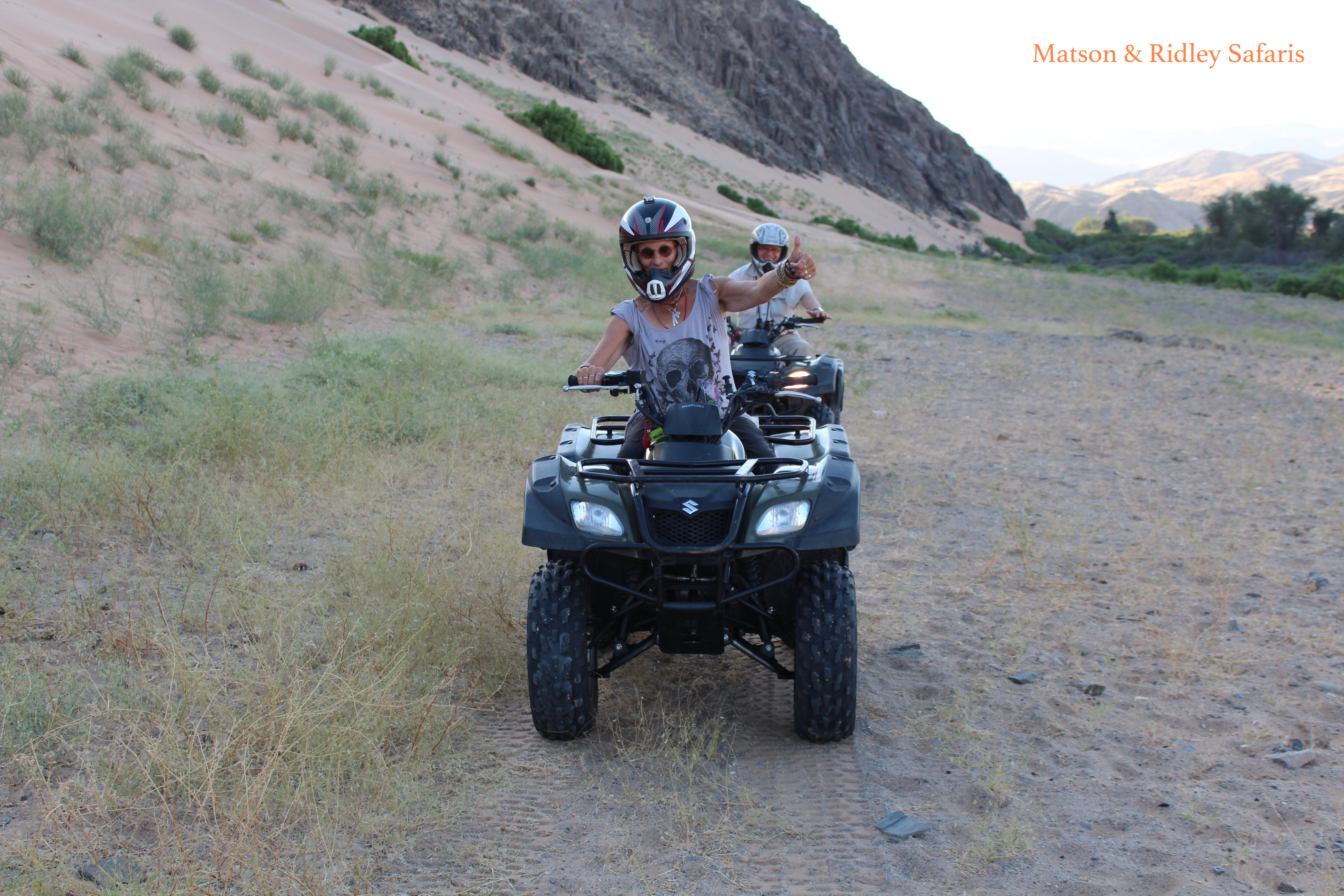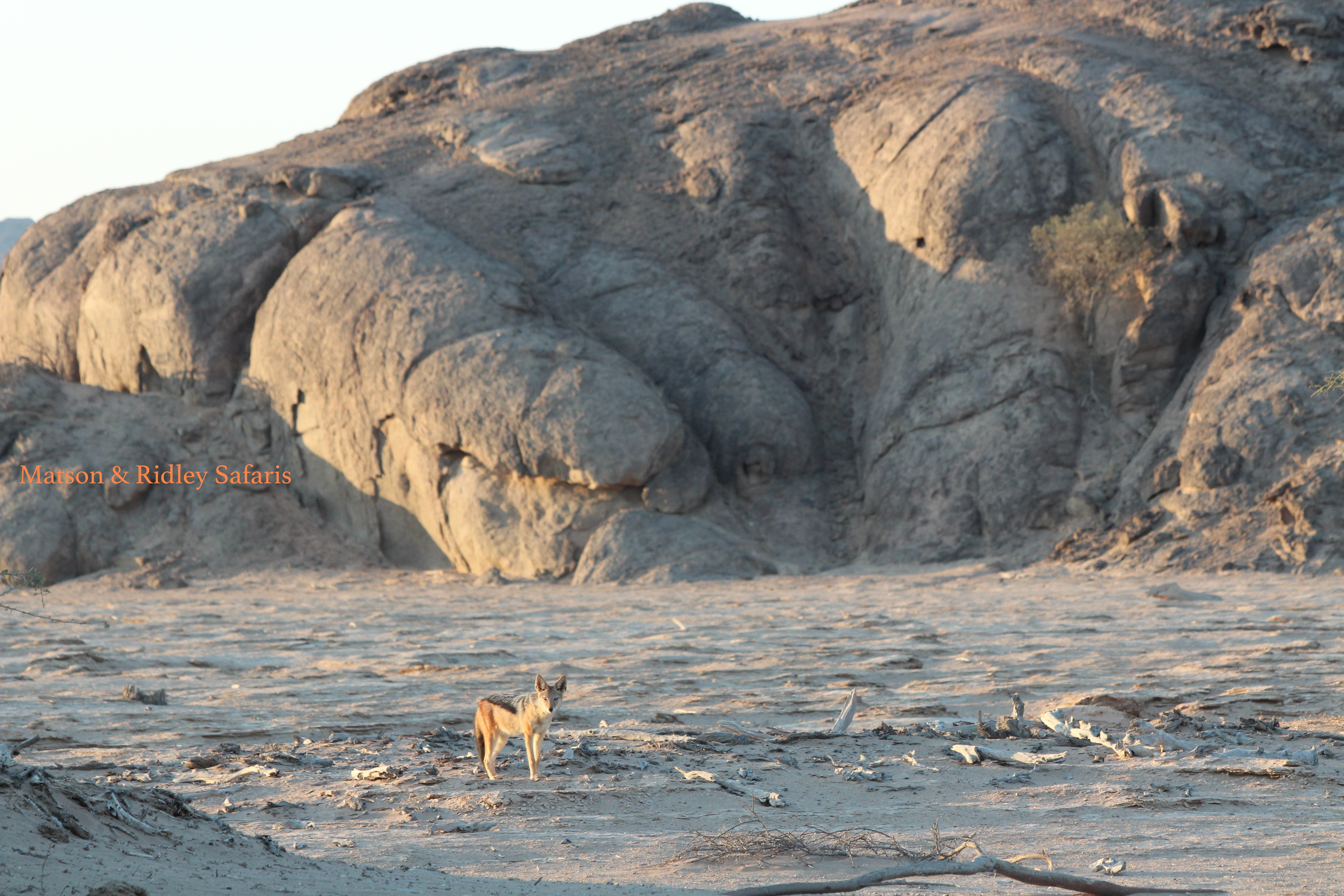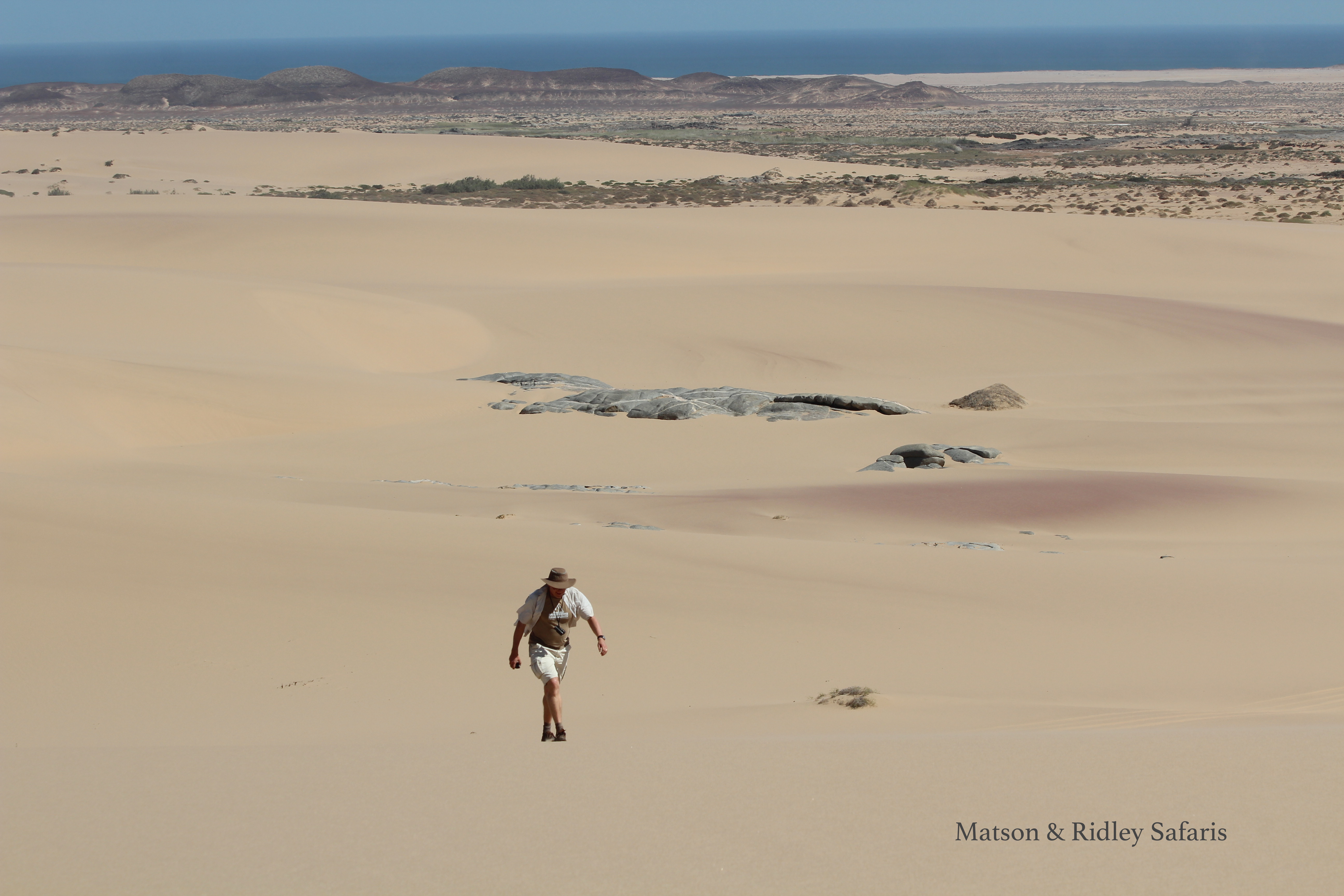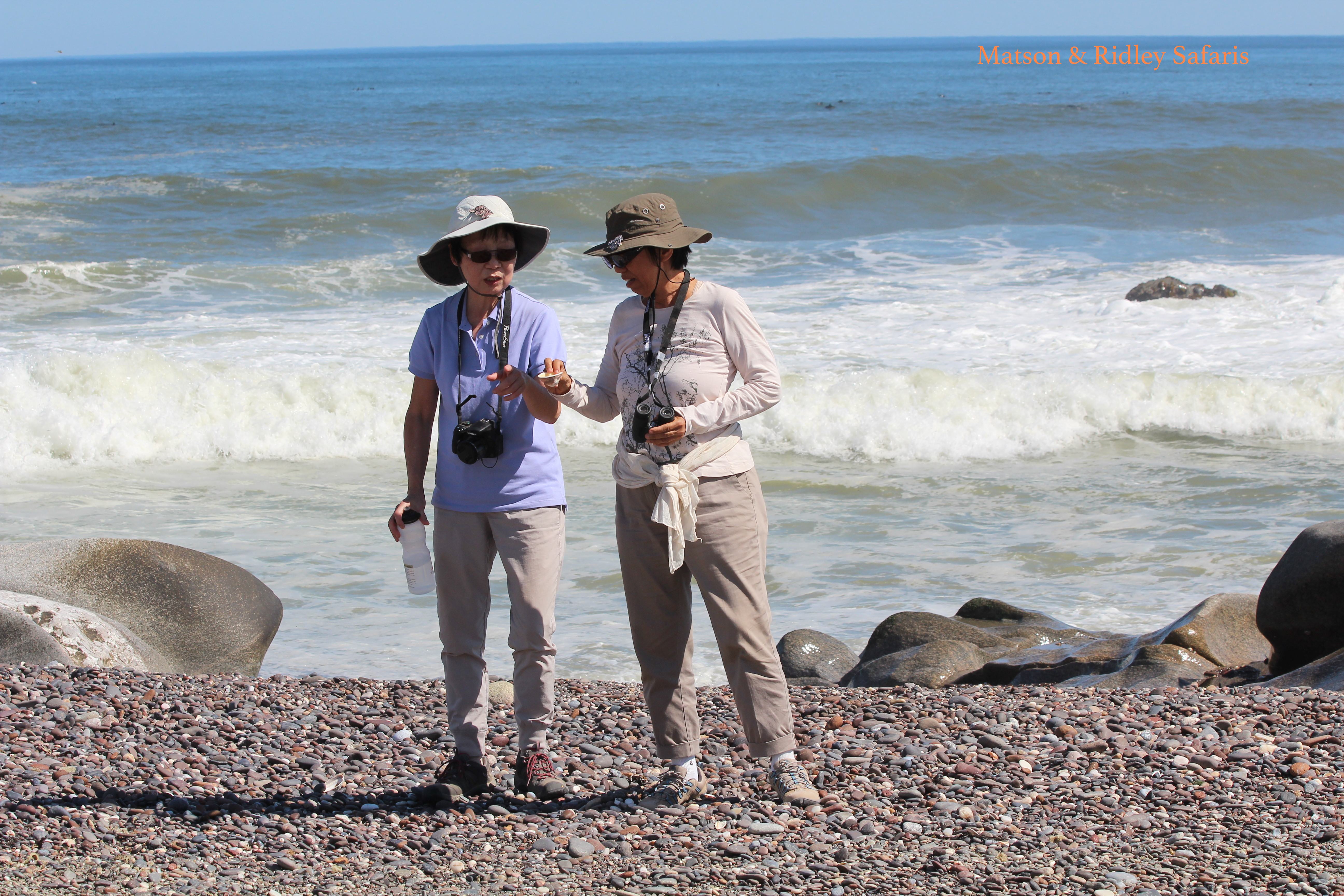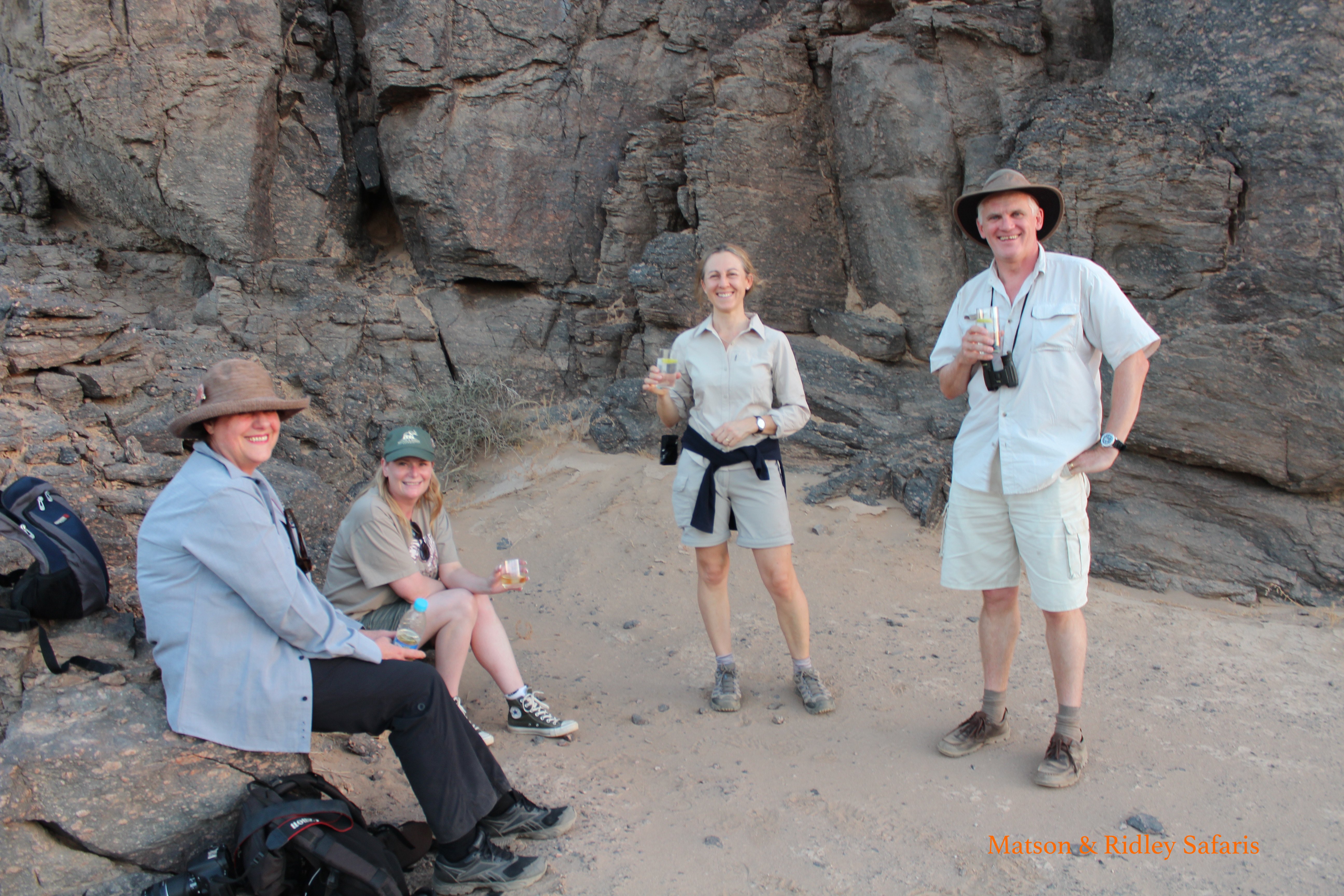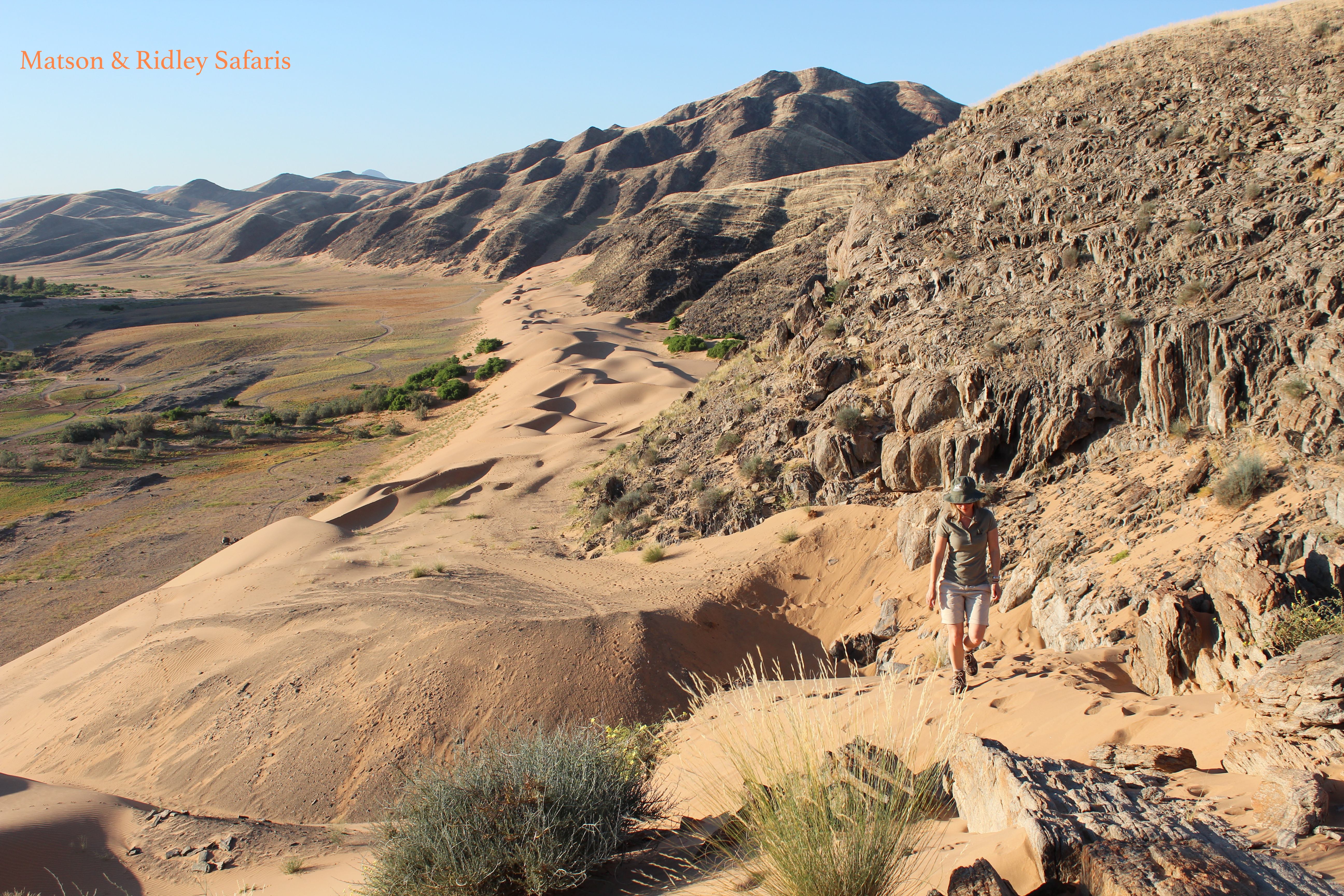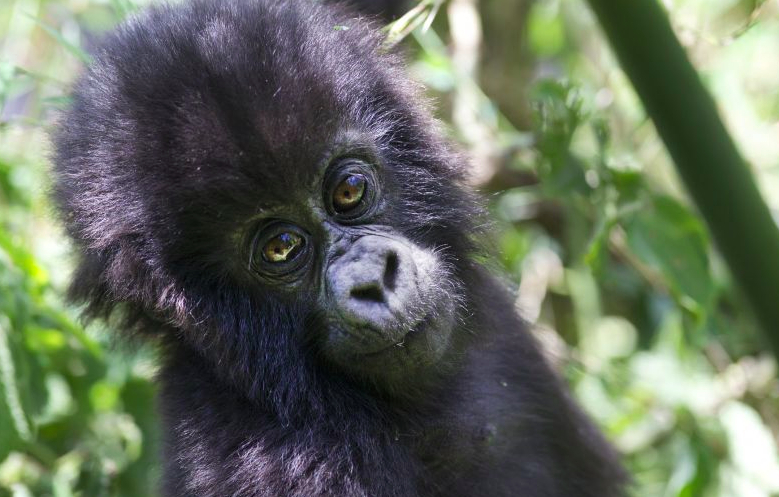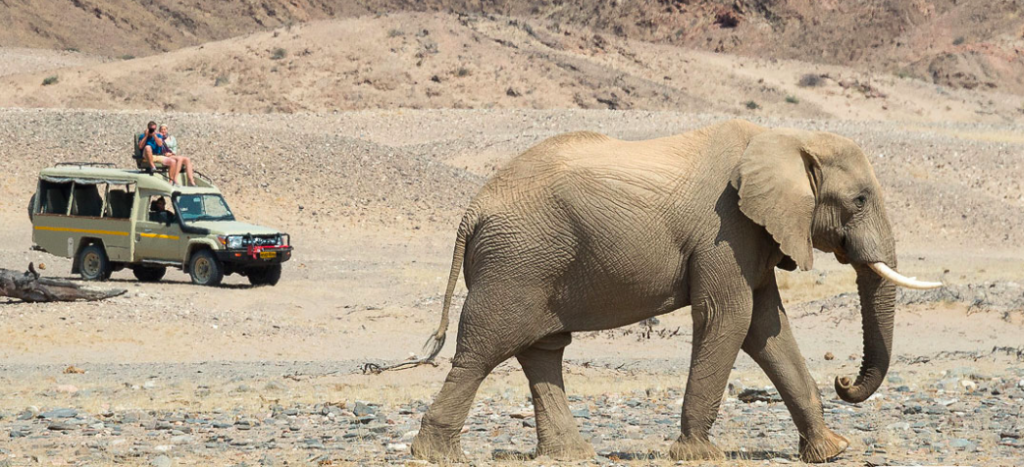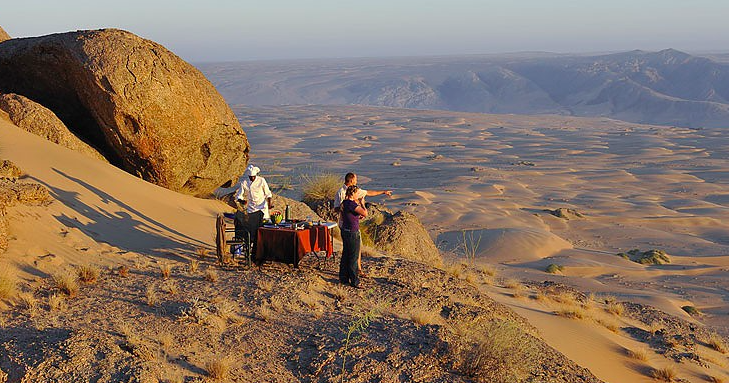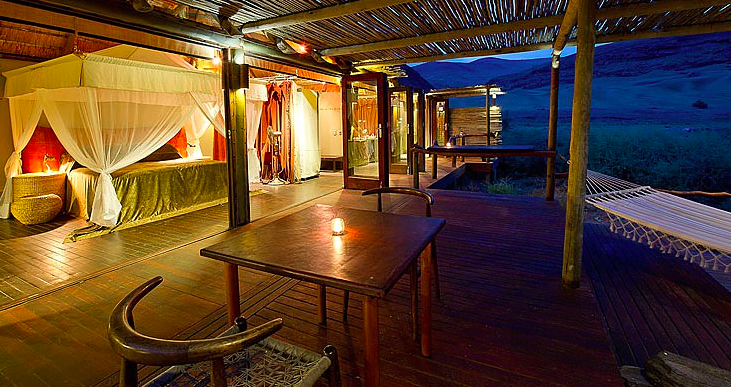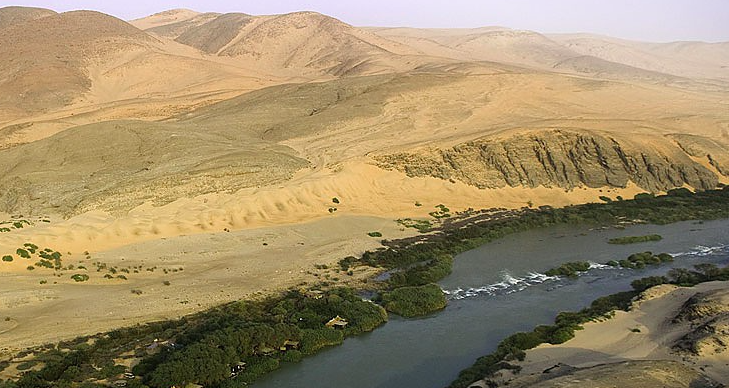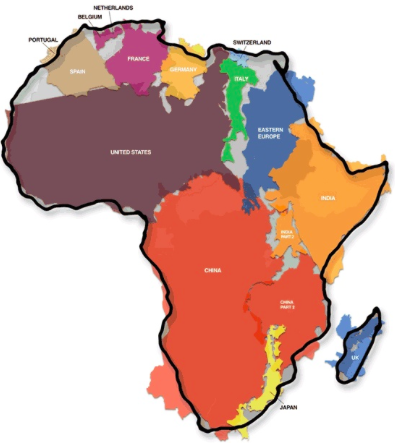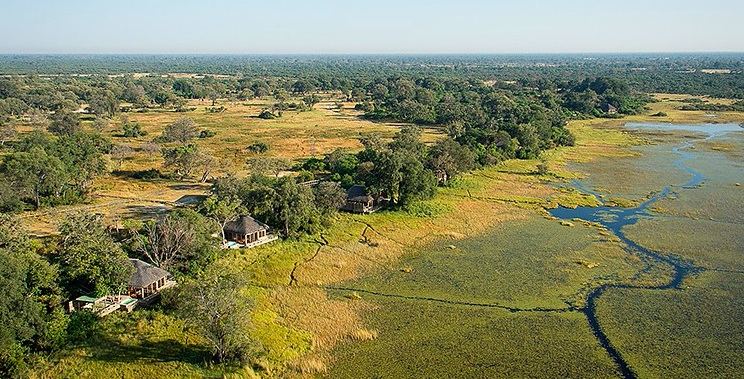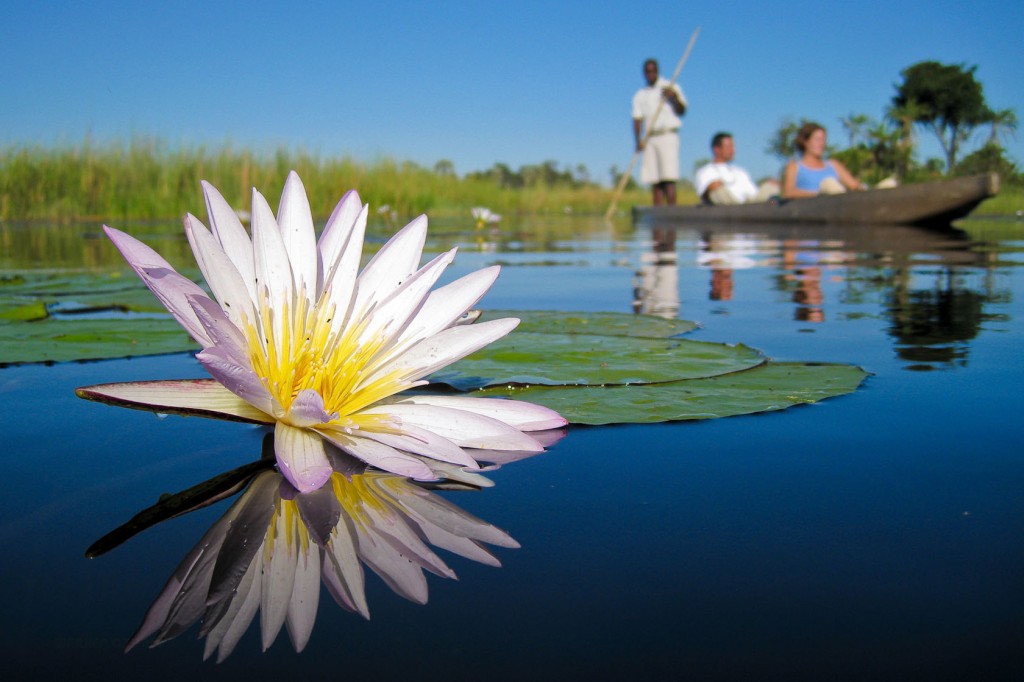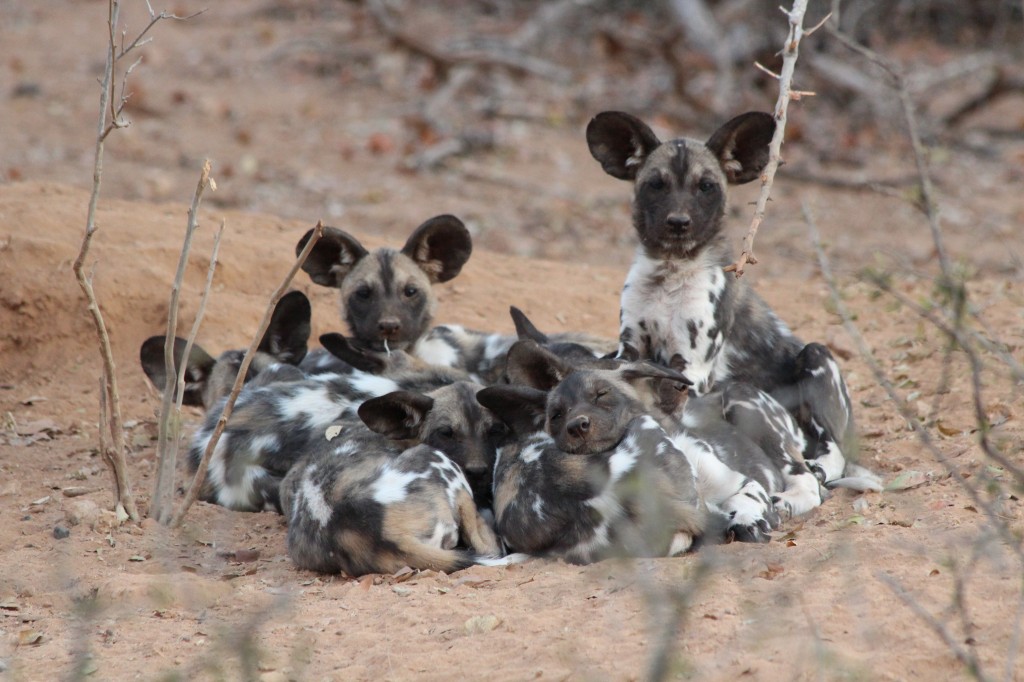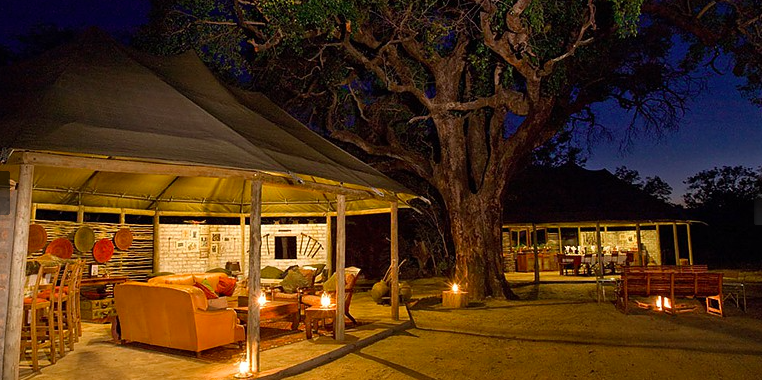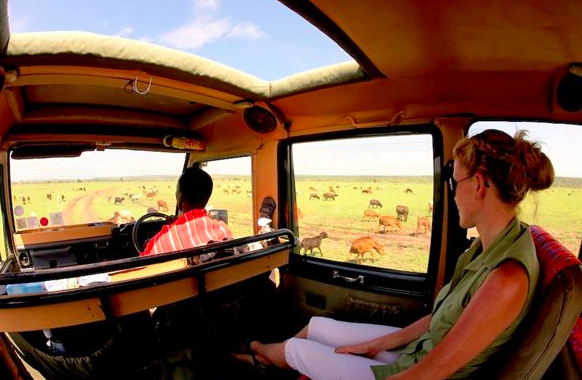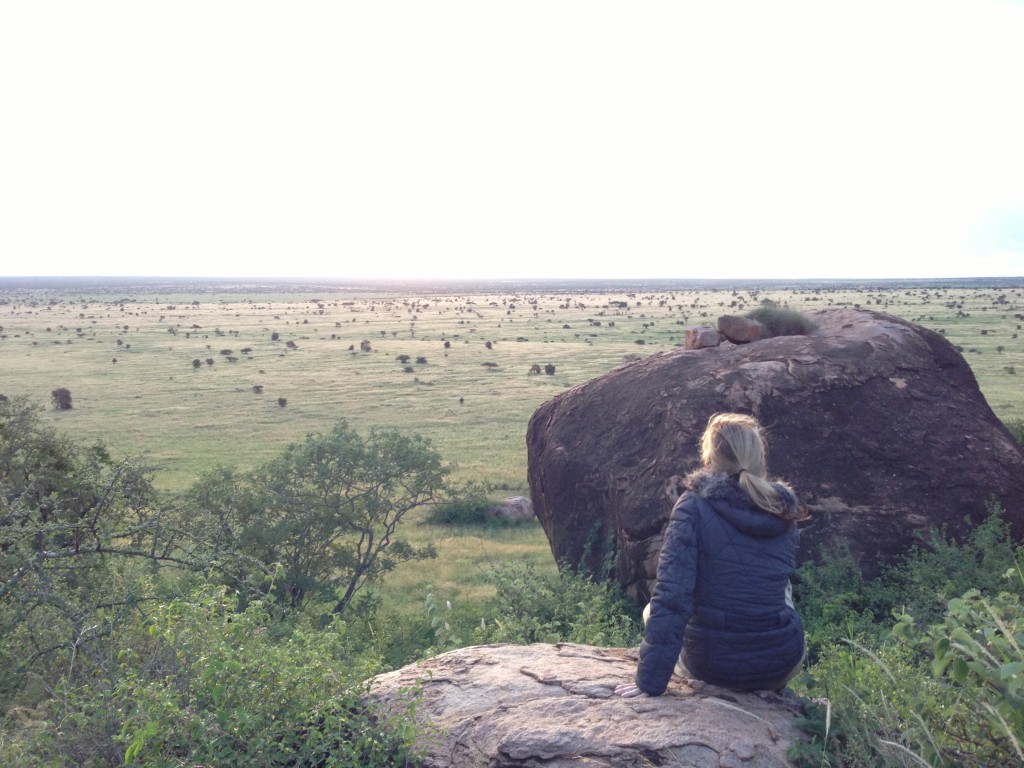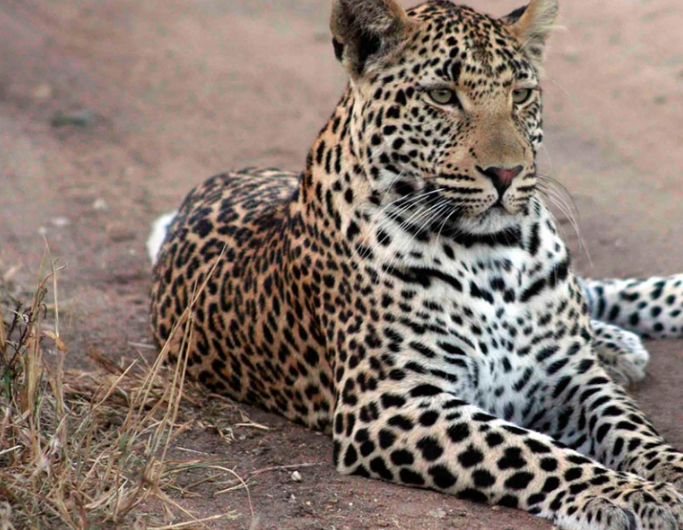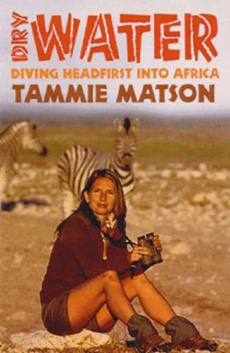Serra Cafema – a world away from everything
There are some parts of Africa that remove you so completely from reality that you start to wonder whether all that stuff that fills your life with worries in the ‘outside’ world really matters much. Serra Cafema Camp, in the Marienfluss Conservancy, is such a place, where traditional Himba people still live a life that is much like what it was several hundred years ago, where a river teeming with crocodiles slices through gothic mountains surrounded by sand dunes, where you can really find yourself by losing yourself in landscapes so primitive you can’t help but feel humbled. There’s no phone range or wifi up here so you can leave all that behind. And you know what – you probably won’t miss it one bit. It’s all about disconnecting to reconnect, as Wilderness Safaris puts it. This is the ultimate escape and a huge adventure.
Here’s my photos of one of my favourite parts of truly wild Africa, our escape to the most remote part of the land that God forgot, as promised in last week’s blog.
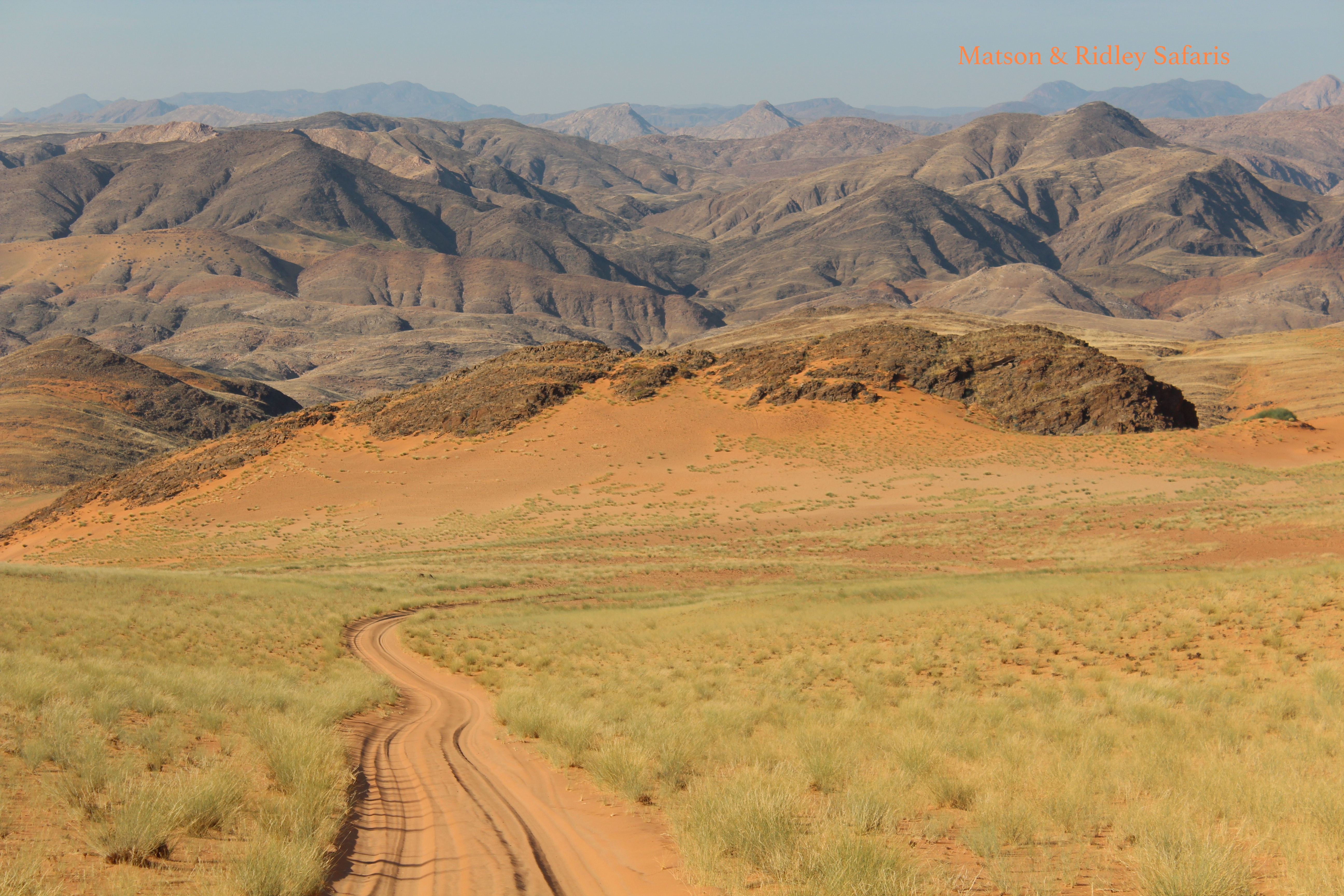
The road to ‘never never’ in the land that God forgot…. It takes several hours in a light plane to get to Serra Cafema from Namibia’s capital city, Windhoek, and then another hour or so to get to the camp itself. They don’t call it the most remote camp in southern Africa for no reason. But it’s worth it. You can’t imagine what it feels like to be in this primeval place with all that space around you without actually going somewhere like this. It’s like taking a step back in time and the colours are simply breath-taking.
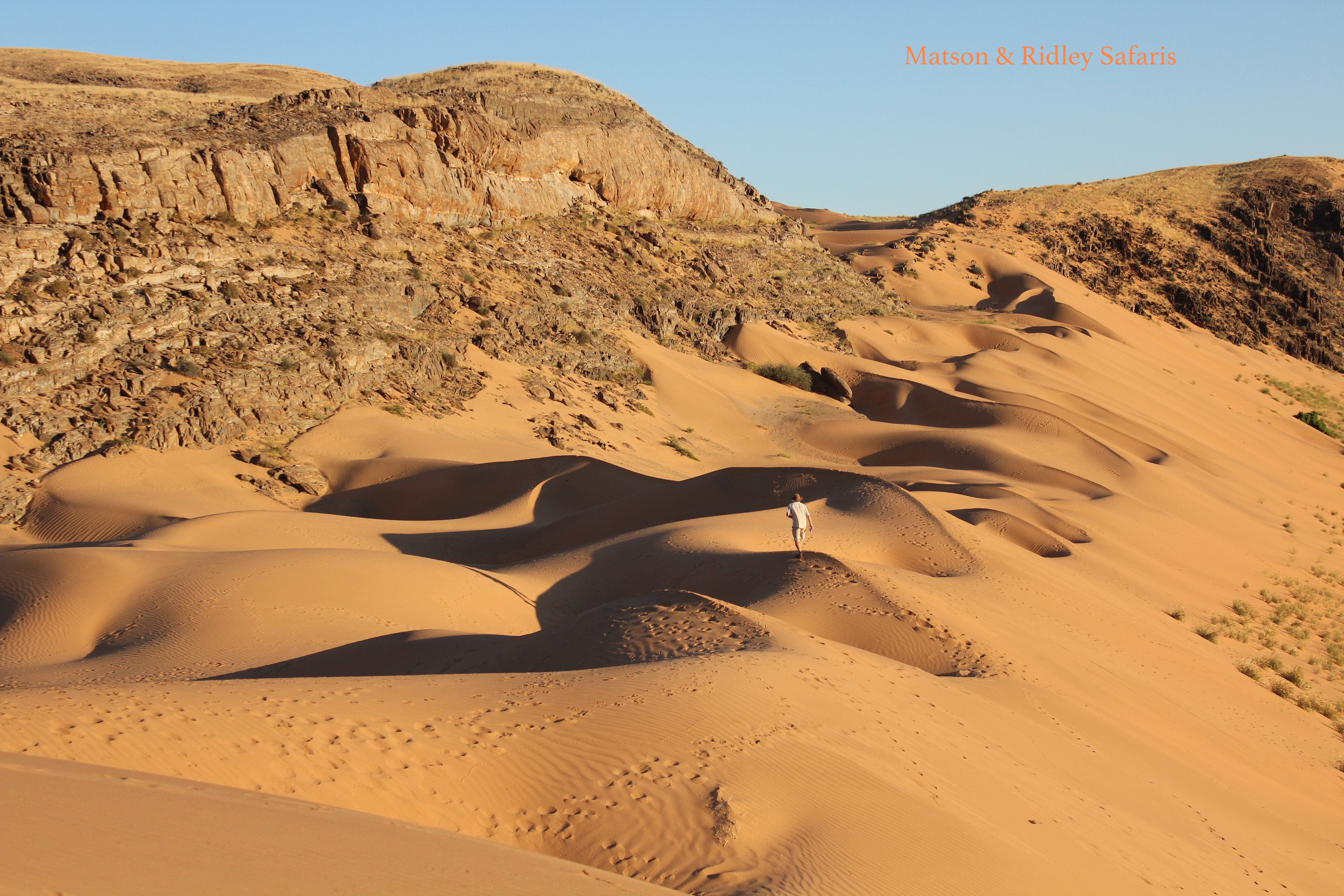
One of the best things about Cafema is that you can walk to your heart’s delight. Here’s one of our group members, Tristan, on a dawn walk in the dunes up behind camp. There used to be lions and elephants and even rhinos in north west Namibia, but the war up until 1990 when Namibia achieved Independence, wiped them all out. It would be incredible to see these species coming back and with the right ongoing management that is possible. Now the species you’re most likely to see in this region are springbok, oryx and ostriches, and for the lucky ones there are also endangered Hartmanns mountain zebras, with their distinctive thin black and white stripes without any shadow stripes. Predators like brown hyaenas and jackals live here too, as testified by their tracks in the sand near camp.
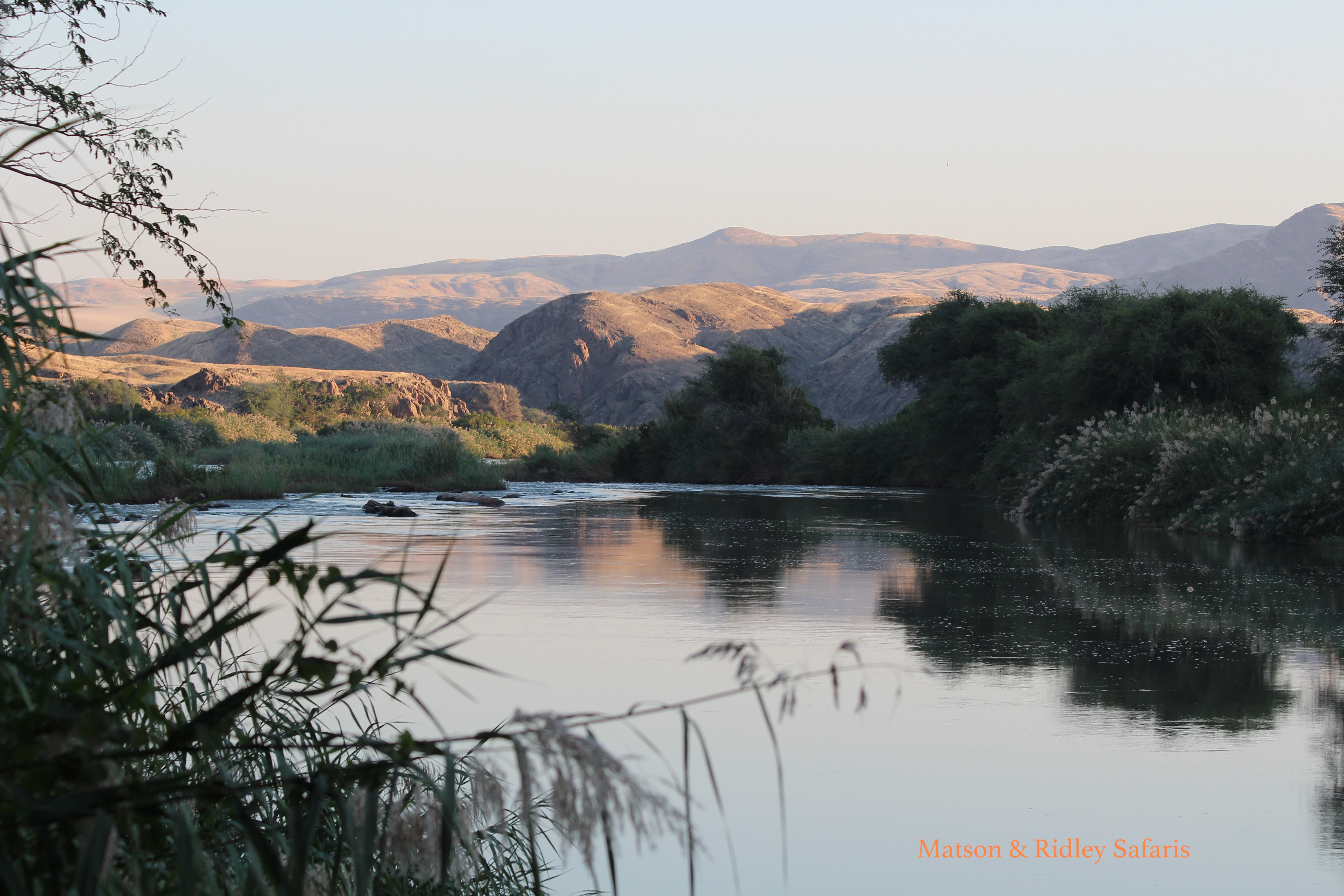
This is the view of the Kunene River that you get on the deck of the main area at Serra Cafema Camp. The luxurious camp is nestled under big shady Ana and Acacia trees and is truly an oasis in the middle of nowhere. You walk to your room along wooden walk ways on stilts. That’s Angola across the river, the Kunene marking the boundary. All day and night you can hear the rapids upstream. The contrast of being in the desert dunes so far from any kind of civilisation with this rushing river that originates in the highlands of central Angola and floods out through the Skeleton Coast to the Atlantic Ocean is mind blowing. But above all, it’s incredibly relaxing. A swim in this river is not recommended, and you’ll see why if you scroll down….
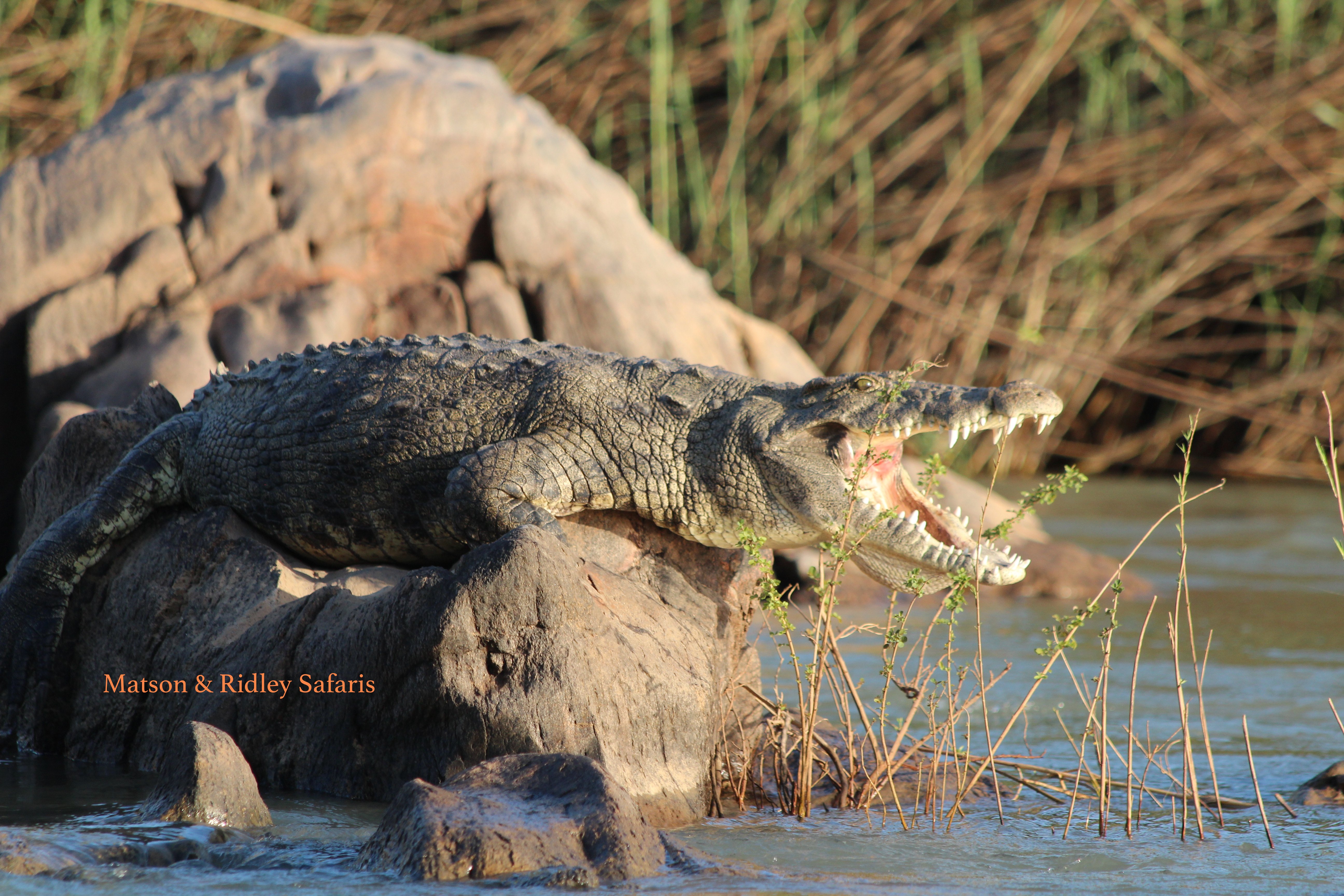
Nile crocodile, sun bathing…. One of the most fun activities at Cafema is an afternoon boat ride up the Kunene River, where you have a good chance to see crocs like this guy sunning in the late afternoon, and abundant bird life. Just before the sun sets the guides pull up at a sand bank on the Angolan side and lay out sun downers fit for kings and queens. It’s a really tough life!
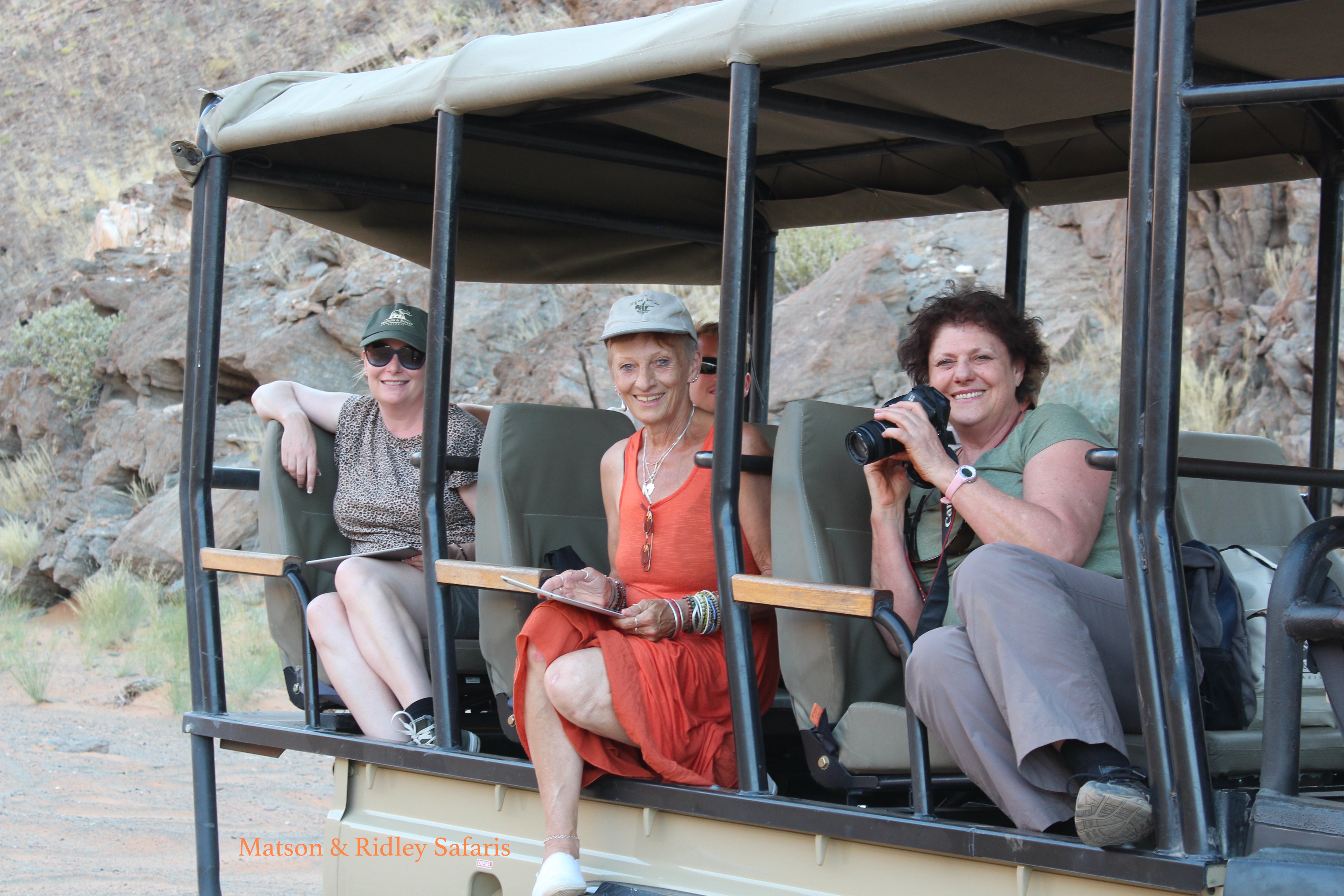
The ‘3 Ozzies’, Joanne, Maggie and Leonie, watching the rest of our group in the other vehicle come down the dunes on the drive into camp. There are some adrenaline rushes as the 4x4s slide down certain roads on steep dunes, which of course the guides do all the time, but the first time you do it you really wonder if you’re going to survive!
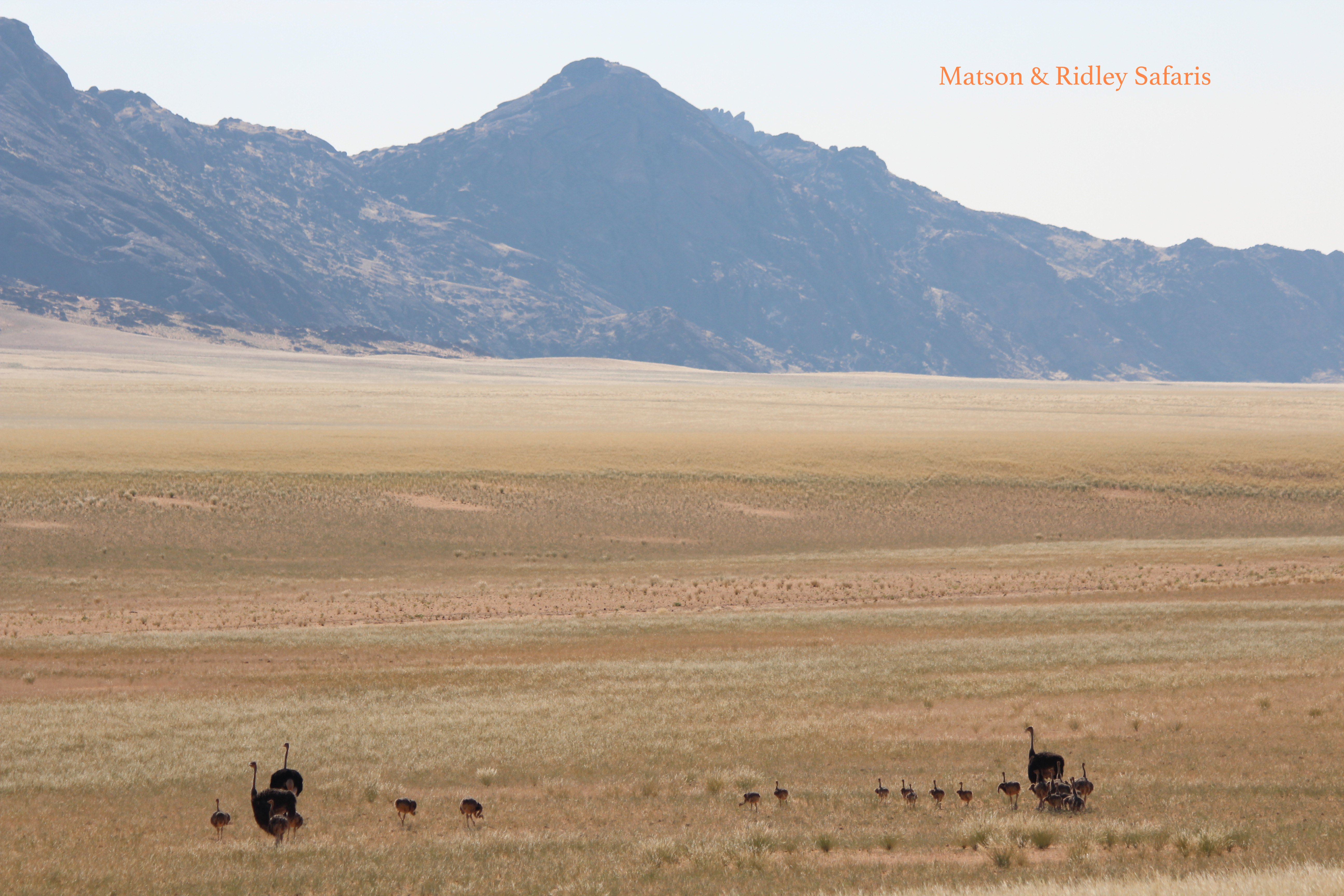
It hadn’t rained in this area for about 5 years, according to our guides, and then 3 months before our visit, the heavens smiled and granted the Hartmanns Valley a generous serve of much needed rain. The result was incredible scenes like this where usually there is only sand, now valleys filled with grass. These ostriches were clearly still celebrating with a large flock of youngsters, taking advantage of the good times to reproduce.
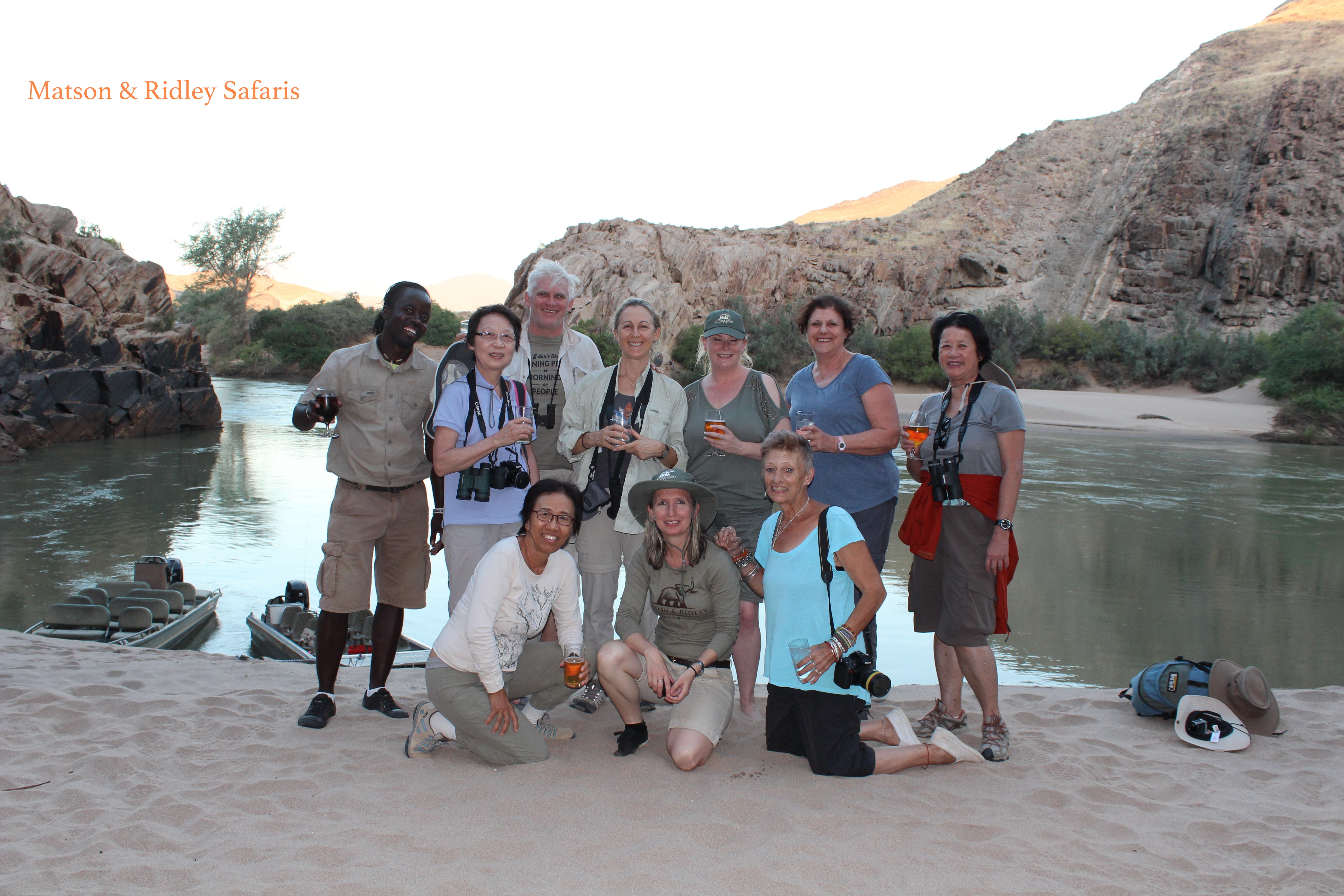
Here we all are having sundowners on the Kunene River with one of our Himba guides, Timo – on the Angolan side without a passport! Back row: Timo, Patricia, Tristan, Carina, Joanne, Leonie, Helen. Front: Chuan Fong, me and Maggie.
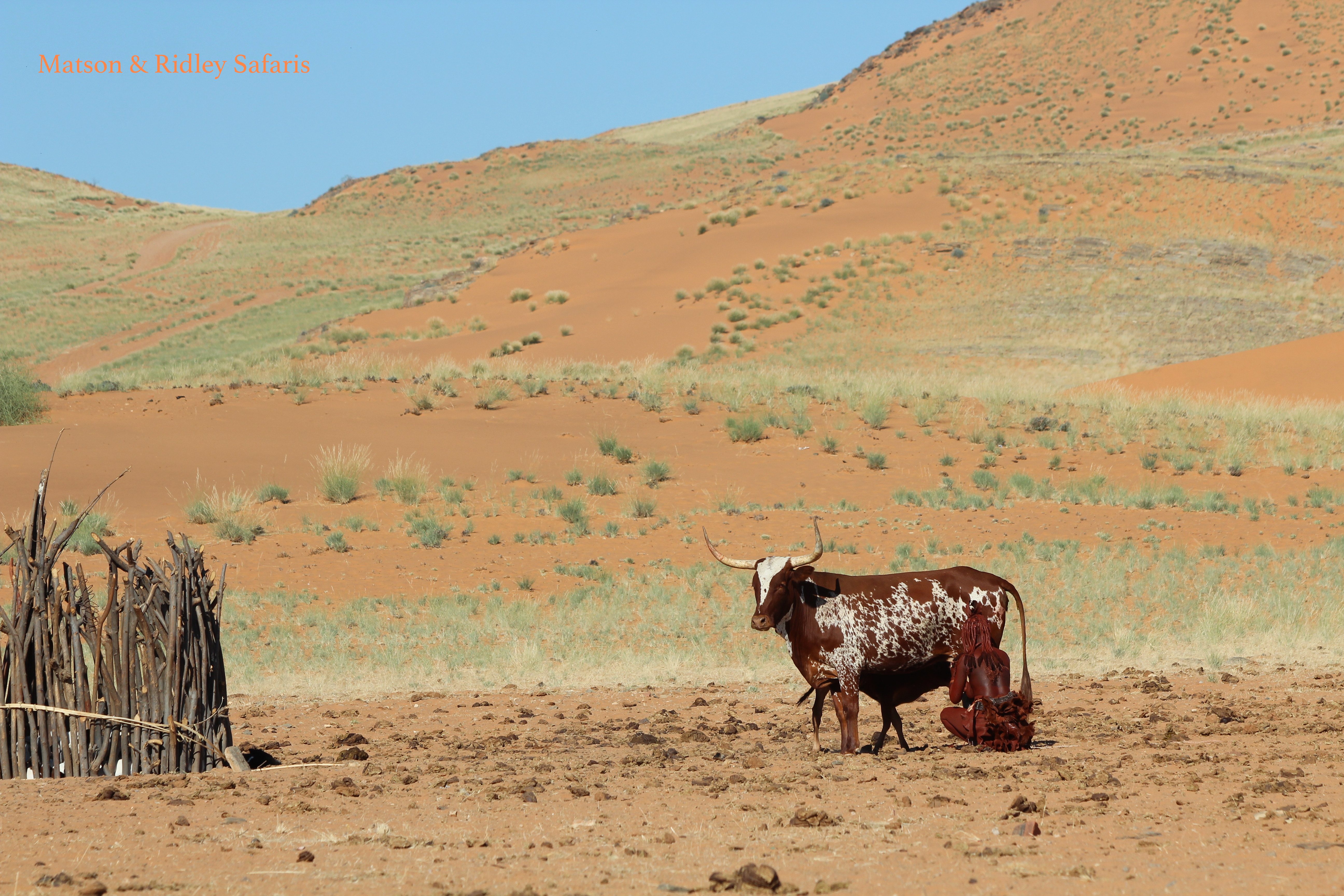
Of course, probably the most special part of the Serra Cafema experience is meeting the Himbas. The Himbas are in a joint venture partnership between Wilderness Safaris who operate the camp and the Marienfluss Conservancy, owned and run by the local people. Our guide Stanley described his people, the Himbas as one of the ‘richest’ tribes in Africa because they have so many cattle. Cattle are the currency in many parts of Africa, used in dowries for marriage and many other exchanges. The Himbas are excellent cattle farmers, semi-nomadic people who move with their cattle to better grazing as needed. I’ve seen this part of Namibia much drier than this and sometimes it’s hard to believe any cow would get a meal out of the amount of vegetation available. They live on milk from the cows and occasionally meat from a goat, trading to get pap (porridge made from ground corn or mealie meal), but they eat very little in the way of vegetables/fruit. Yet superficially they seemed very healthy to us and no doubt the rains brought great rejoicing in this part of the world.
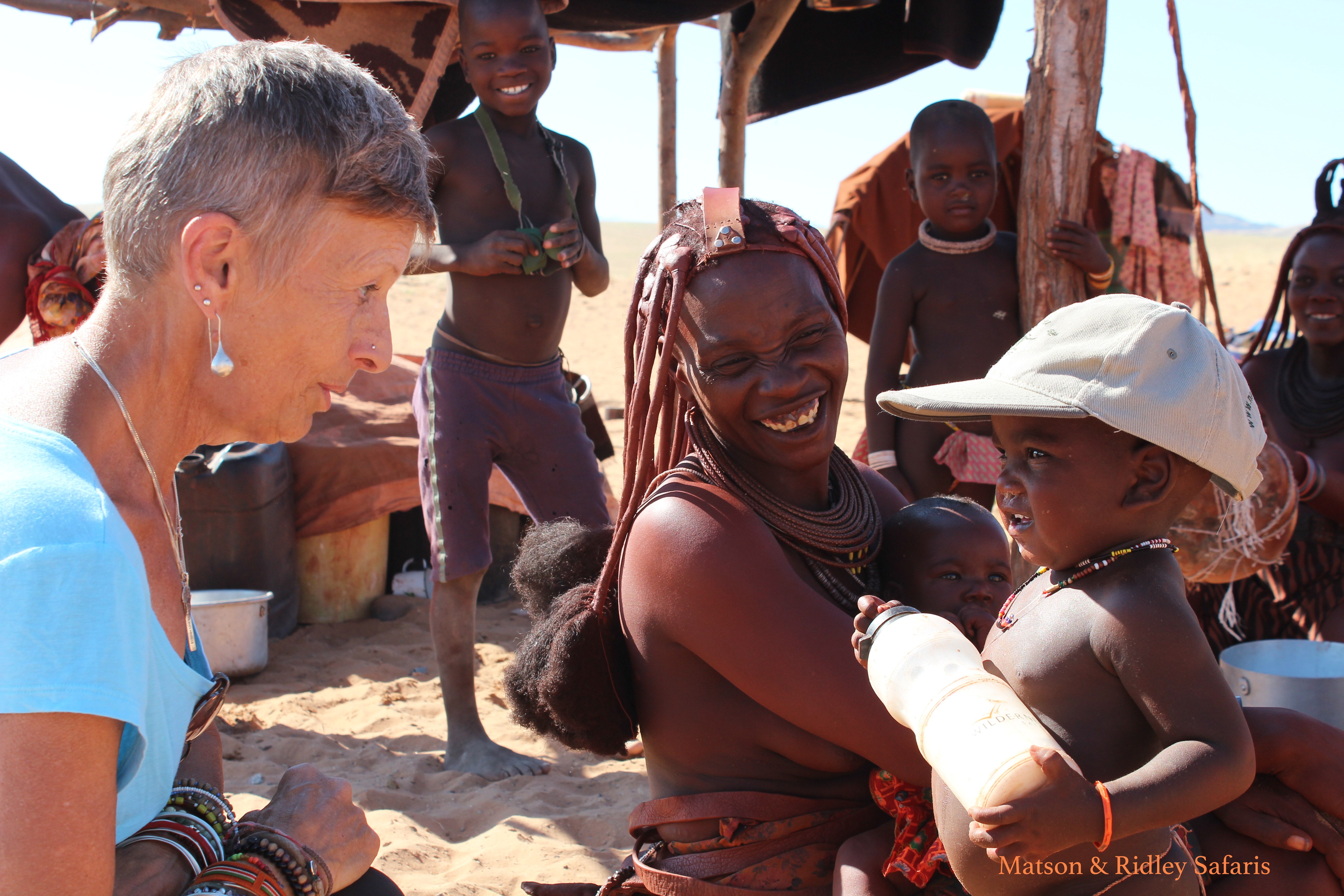
Interacting with the Himbas is really special and definitely a highlight of the visit. Here Maggie has a chat to a little Himba boy who clearly seemed to be enjoying the one-on-one, as mum watched on beside him with her young baby.
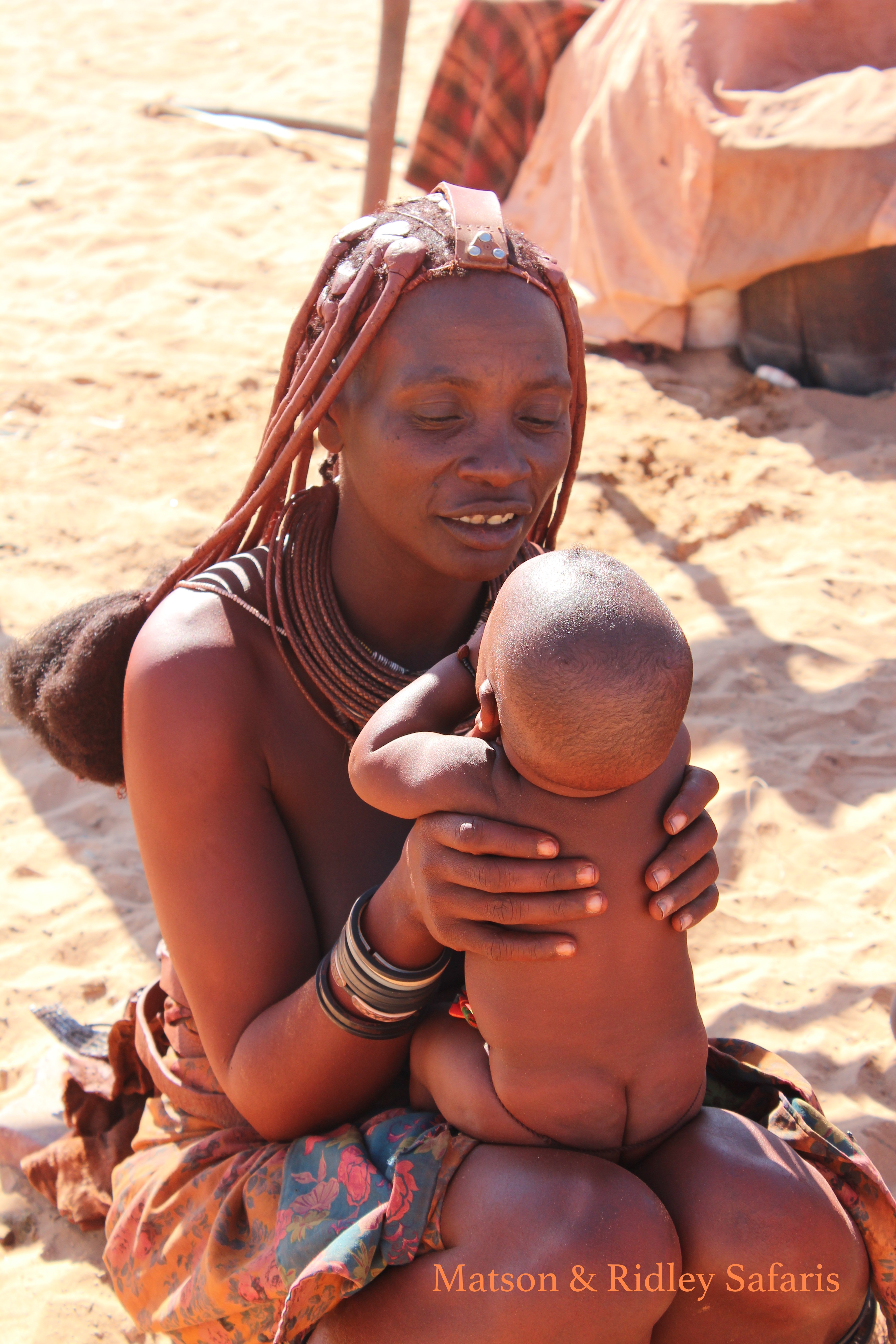
I’ve always loved watching the Himba women with their small babies. The look on the mother’s face above makes you think she could be any mother in the world. The ‘midwife’ who helps the women give birth is the old grandmother in the village. There are no medical doctors or hospitals out here.
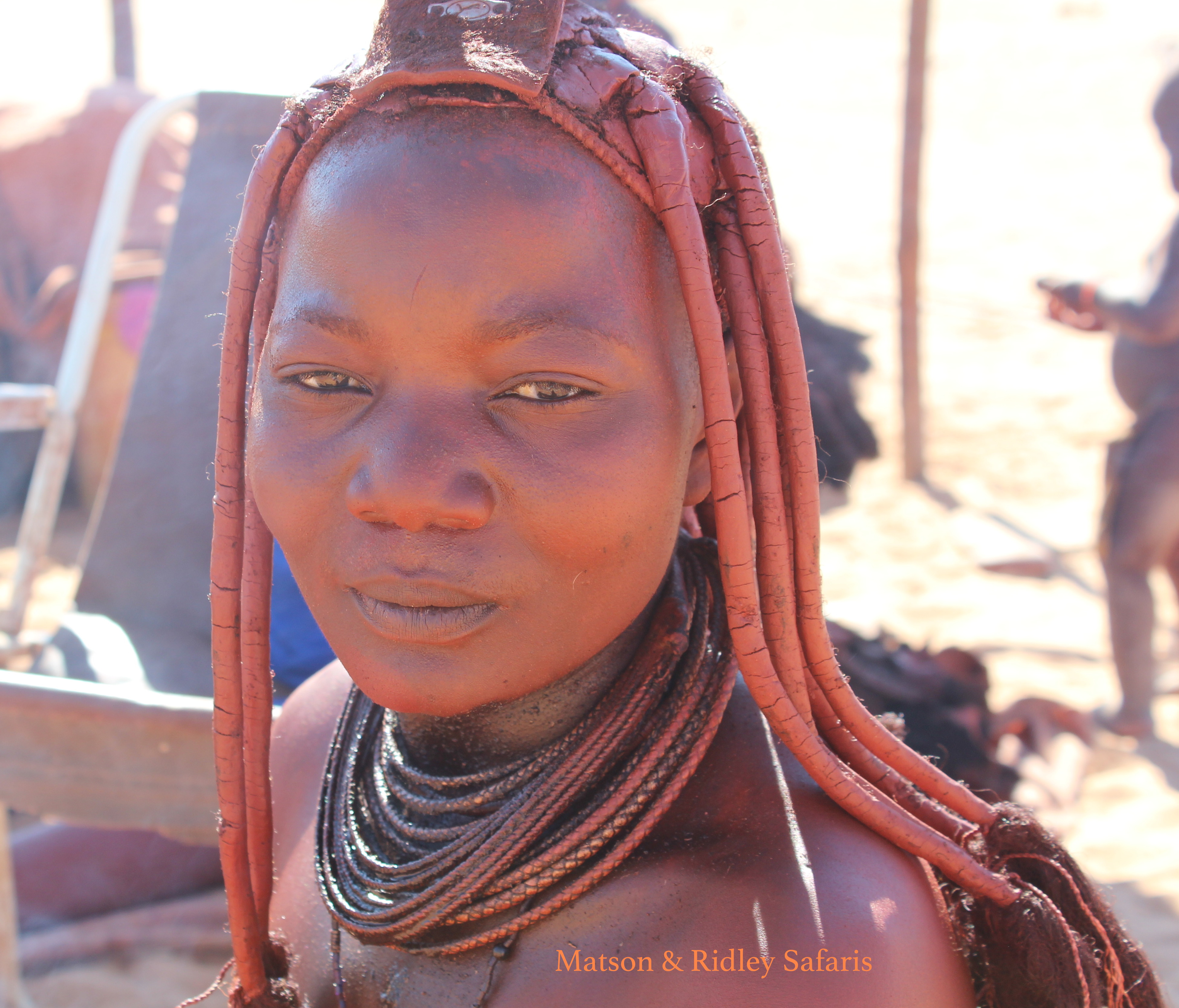
Women in Himba culture wear a special head dress if they are married. The red ochre that they cover their bodies with acts as a sunscreen and a moisturiser, but it’s also there for beautification purposes. Himba society is polygamous; men can have several wives. Let’s just say feminism hasn’t hit Himba society yet and I don’t think it will for a while!
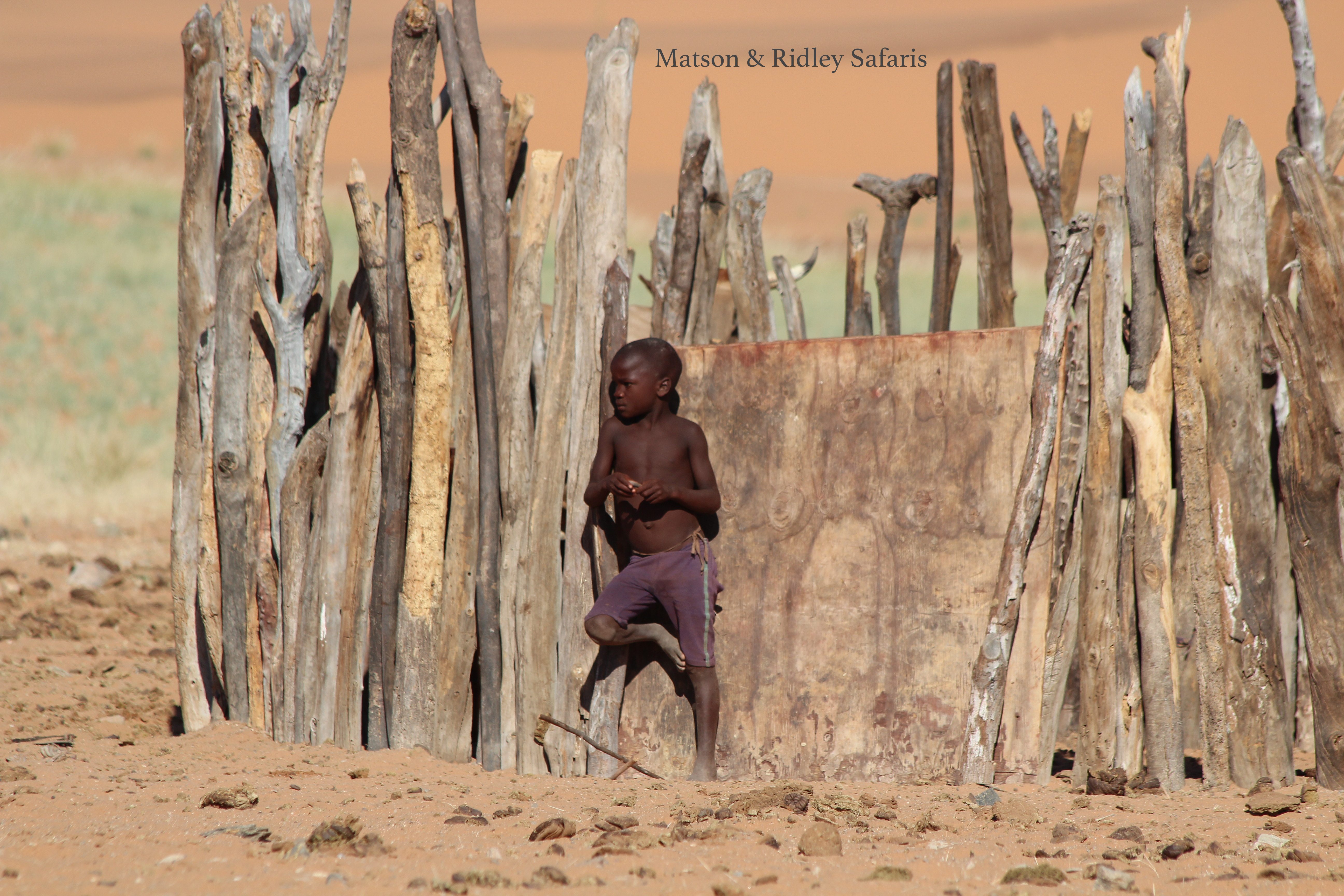
Some of the kids now go to school, but not all of them. It’s easy to see how going to school could bring conflicts into the lives of these very traditional people, even though it’s important that they are represented and have their say in the country where they are a minority population-wise. Education is essential for this but it doesn’t come without challenges. One of our guides, Stanley explained how he had been educated at a Christian school and this had created a conflict in him. Now that he believed in the bible because of his school, he explained, it was hard for him to feel okay with the Himba worship of the ancestors in the ancestral fire. The two didn’t go together well. It was explained to us that the Himbas believe that when you die, you go into the ancestral fire and you are still ‘there’ with the people, accessible through the fire, but not really gone. I’m not sure I’ve got that 100% right, but it’s certainly not a philosophy that sits too easily with Christianity. So I could see how bringing in modern ways of thinking from the outside world would be seen as a threat to Himba culture and tradition.
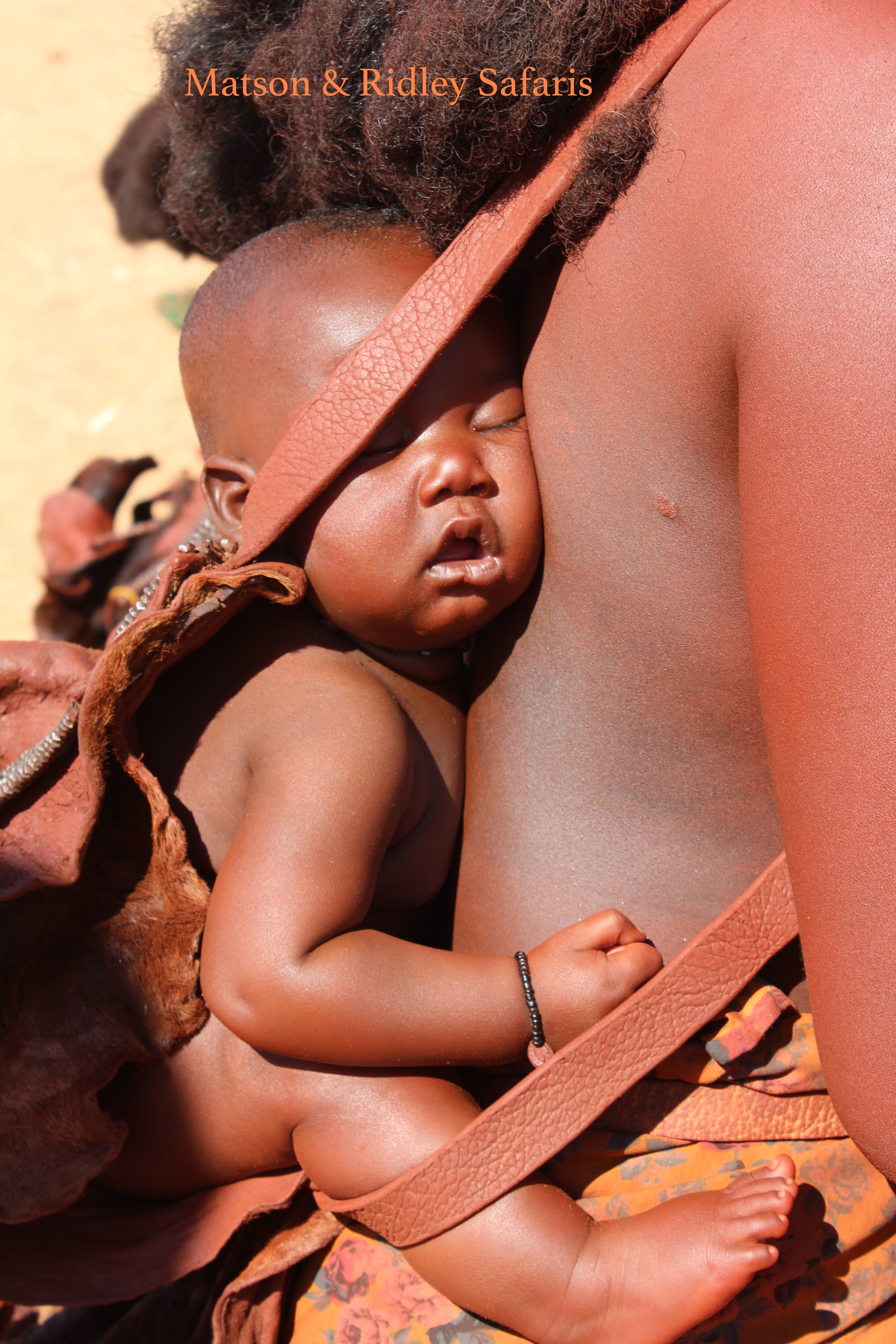
As soon as she strapped him onto her back, this baby fell right asleep. Mum resumed her work as if he wasn’t even there!
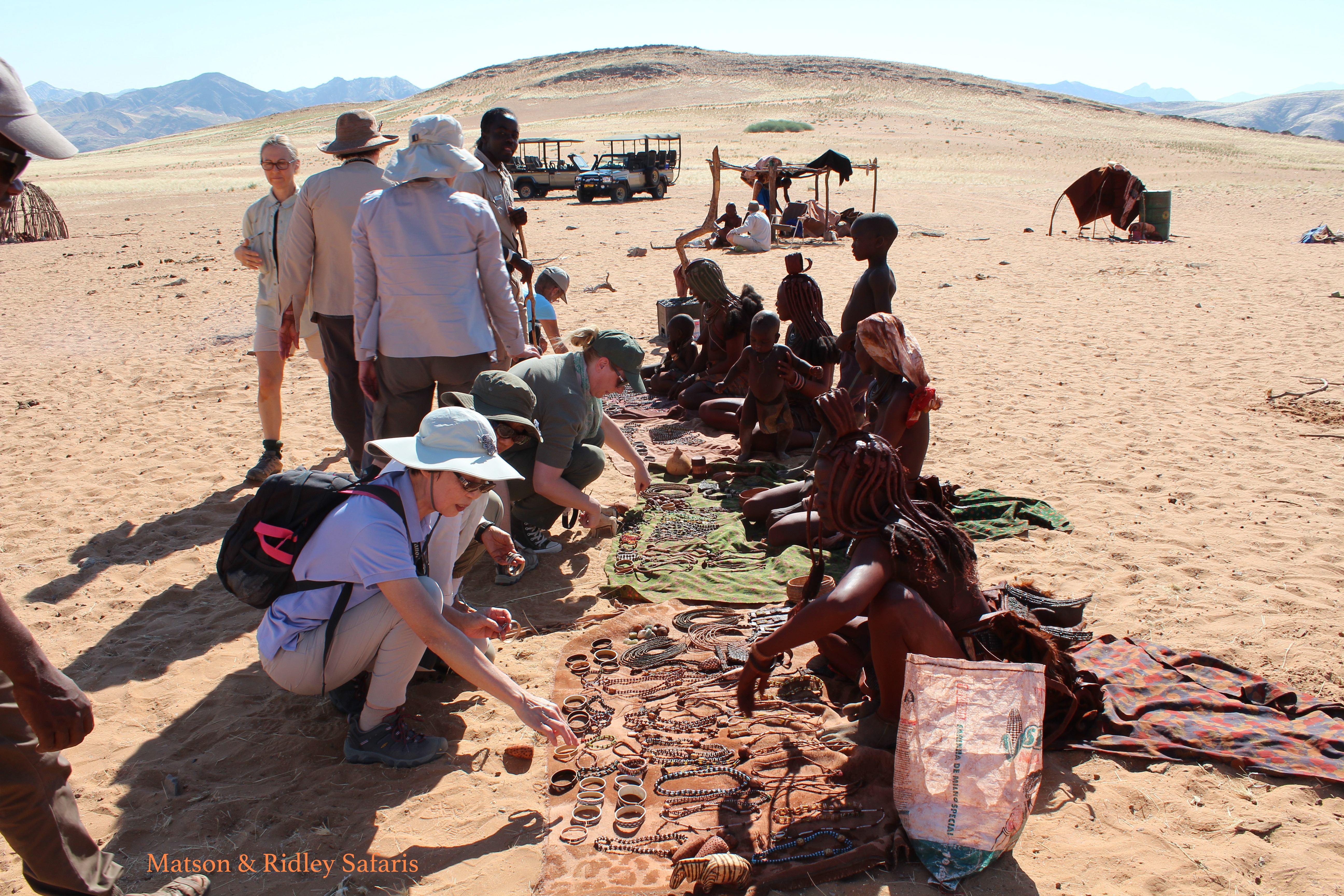
The Himba women seemed thrilled to be able to sell some of their jewellery to our group. I think we made a good contribution to their small businesses!
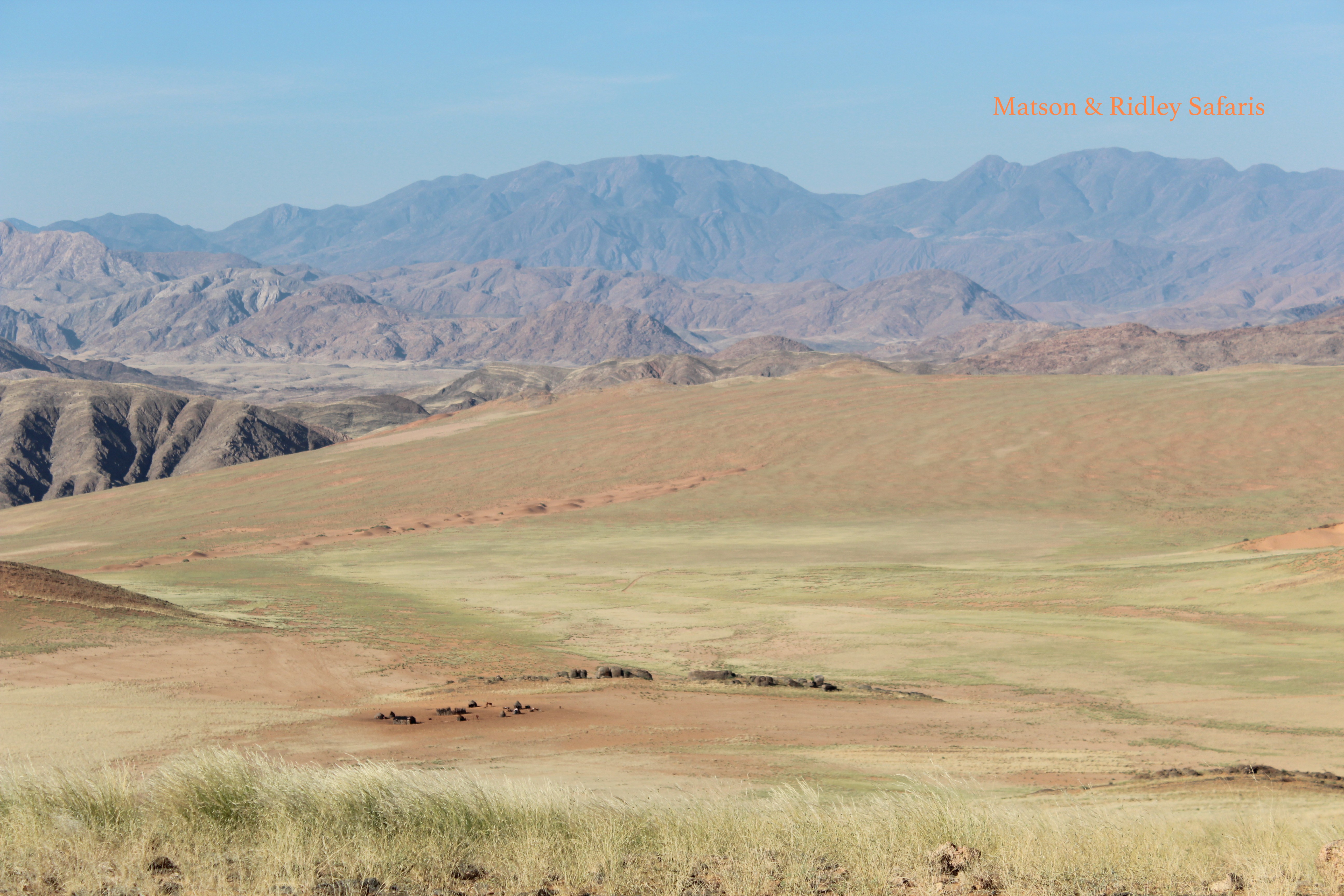
In the foreground in this picture you can see the Himba village. If only our own cities were as unobstructive in the landscape as theirs! That’s the hills of Angola in the background.
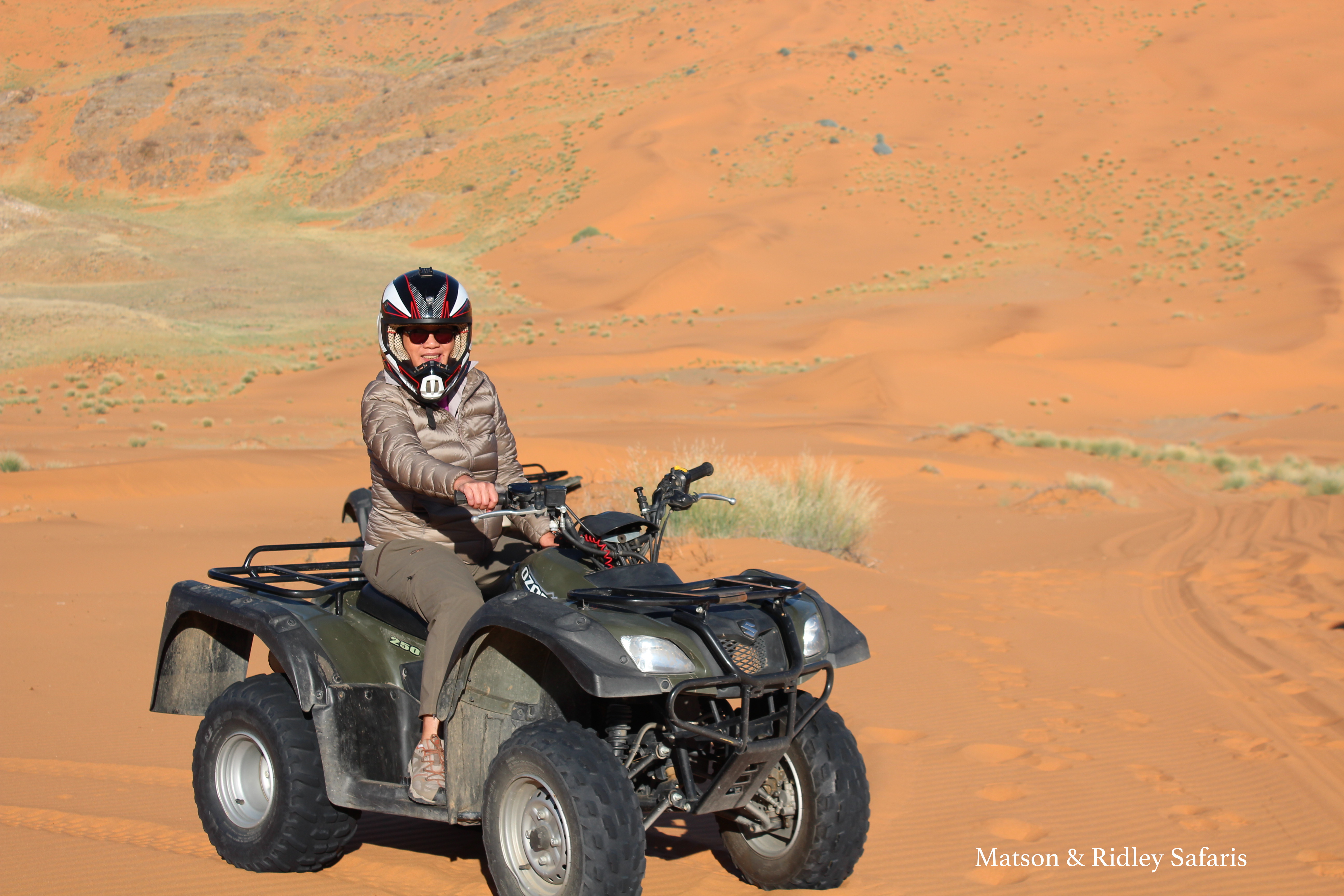
One of the fun adventure activities you can do at Cafema is hop on a quad bike and explore the landscapes from behind the wheel of your very own crazy demon 4×4. Here’s Helen just as we were about to take off. For some of my group, this was the first time on a quad bike. They are easy to use and don’t take long to get the hang of. It’s an awesome way to explore the area, and a whole lot of fun too!
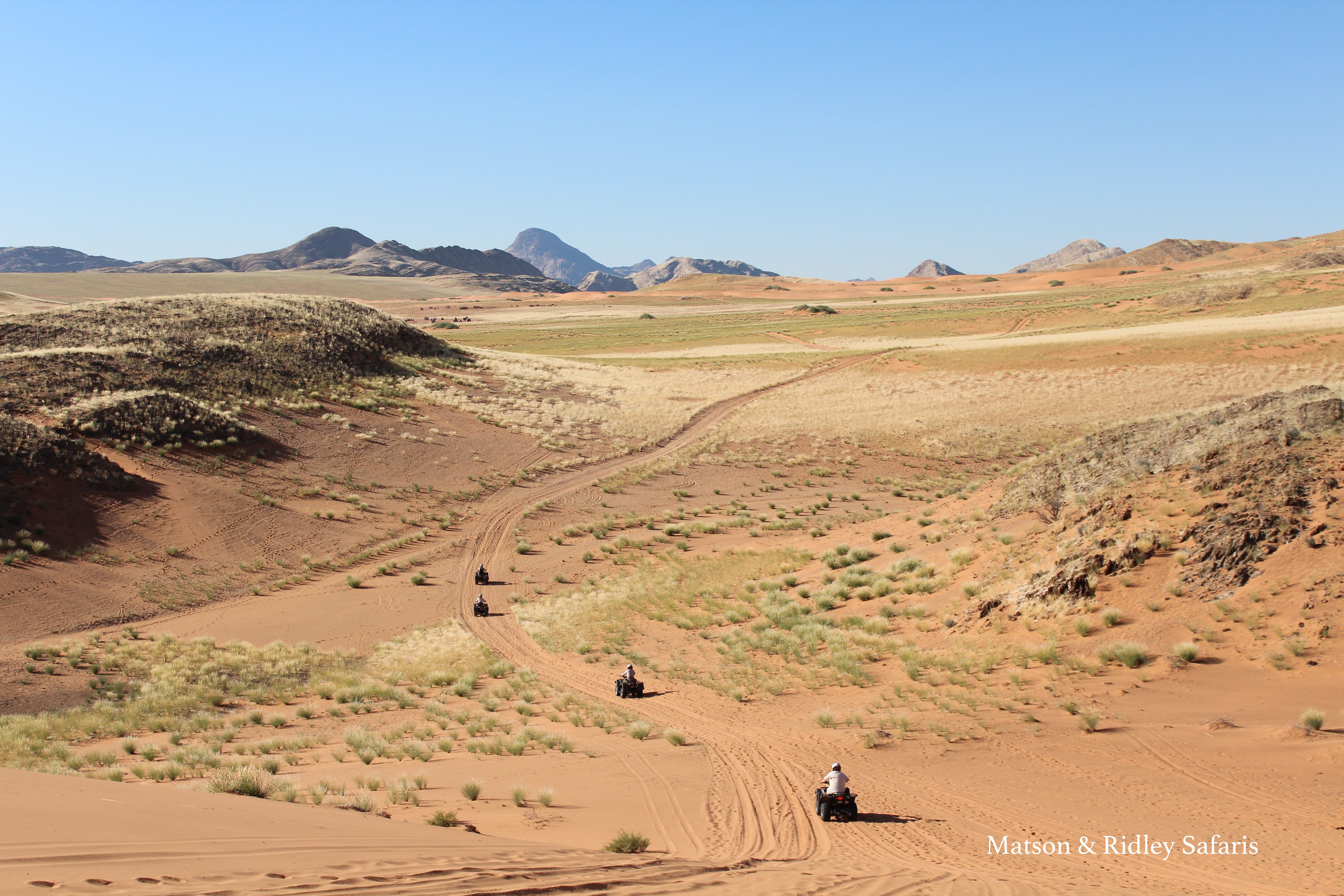
On the last morning, after a special request from Helen, those of us who wanted to were able to quad bike our way all the way to the airstrip. What a thrill this was! One of the most incredible things was watching hundreds of springboks congregated on the plains running through the grass as we drove by. Absolutely unforgettable.
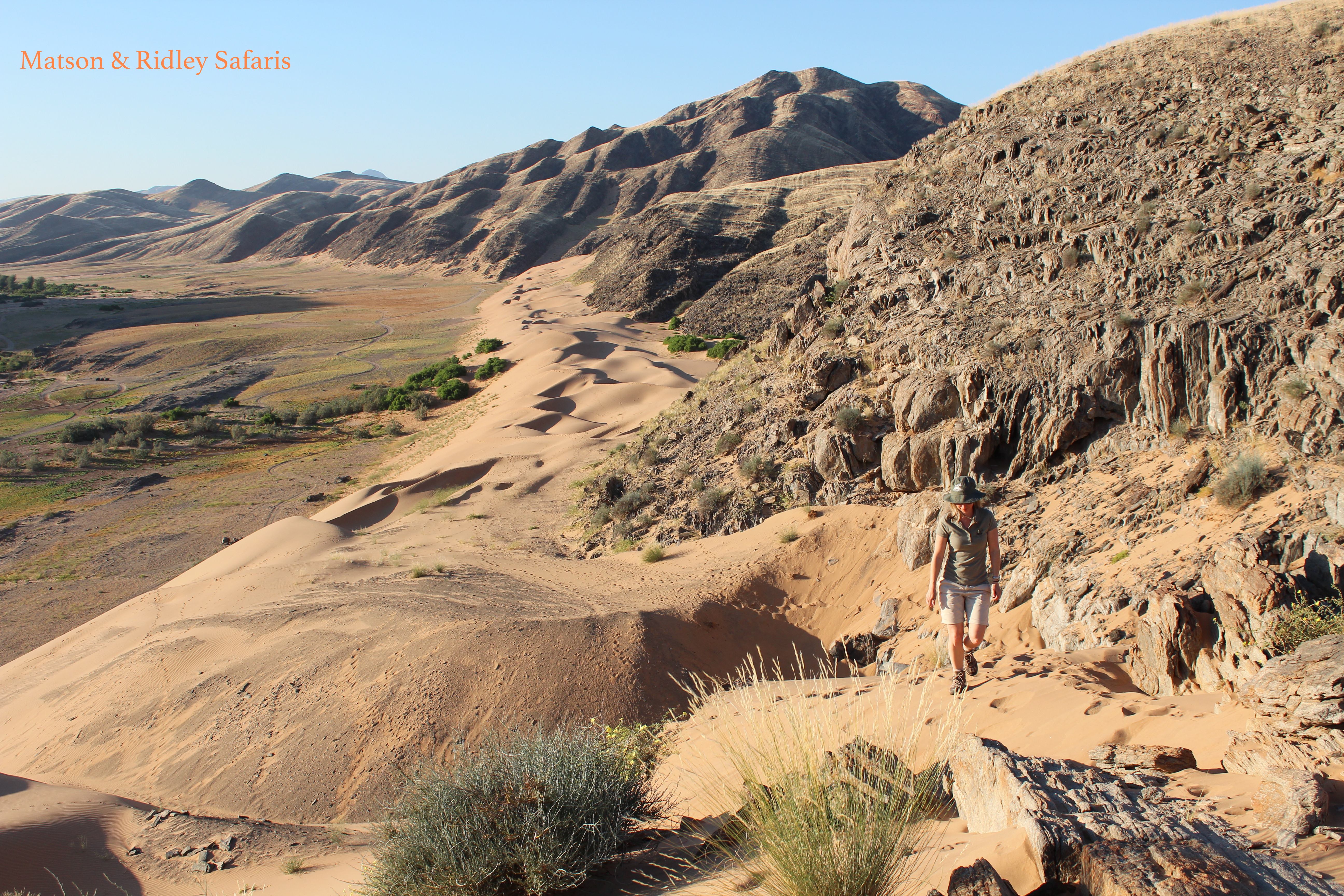
Well of course I have many more photos but there are way too many to share here. Serra Cafema is one of those places that you have to see to believe. Like Maggie kept saying as we drove in from the airstrip, “This is just mad!” and it really is hard to believe such a landscape exists in the modern day. It’s getting harder and harder to find these truly wild places. Of course it’s not without its human impacts, but the Himbas are part of this environment and custodians of the land. As the landlords of the Marienfluss Conservancy and Serra Cafema Camp, it’s up to them to conserve this region, their home. By going there to visit, we all contributed to their livelihoods through ethical tourism, and with the potential threat of the government building a dam on the Kunene that would flood part of the region, the income and jobs that Serra Cafema provide are essential to the future of this area. I can’t wait to go back…. I think Chuan Fong summed it up best when we were standing on a mountain overlooking the Kunene on the last day: “This makes me happy.”
Wow Moments from Namibia’s Wild North West
How does one summarise a week in Namibia’s rugged Kunene region, one of the wildest parts of Africa? It was just one wow moment after another! There was the cheetah mother with two cubs who killed a springbok male in the dry Hoanib River bed, the chameleon laying eggs at the Skeleton Coast, the drive through the dunes to the violent Atlantic Ocean where hundreds of seals frolicked in the crashing waves, meeting the traditional Himbas in Marienfluss Conservancy and of course, the desert lions (with cubs!) and desert-dwelling elephants…. And then there is those epic landscapes, so huge and awe-inspiring that you feel so small and incredibly humbled by it all.
It’s hard to sum up north west Namibia in one blog because it’s so much more than a holiday – it’s a life changing experience and a grand adventure! I think the photos tell the story so let’s start with that…. This week I’m sharing a few of my pictures from the Hoanib River and Skeleton Coast. Next week stay tuned for photos from Serra Cafema in the Marienfluss Conservancy, home to the Himba people. Hoanib Skeleton Coast Camp is a joint venture between Wilderness Safaris and local people in three conservancies, Sesfontein, Anabeb and Torra. Matson & Ridley Safaris also made a donation to the Giraffe Conservation Foundation from this safari. I want to thank Helen, Chuan Fong, Patricia, Maggie, Jo, Leonie, Tristan and Carina for being such intrepid desert adventurers and great company, and I really hope we meet again by the campfire soon.
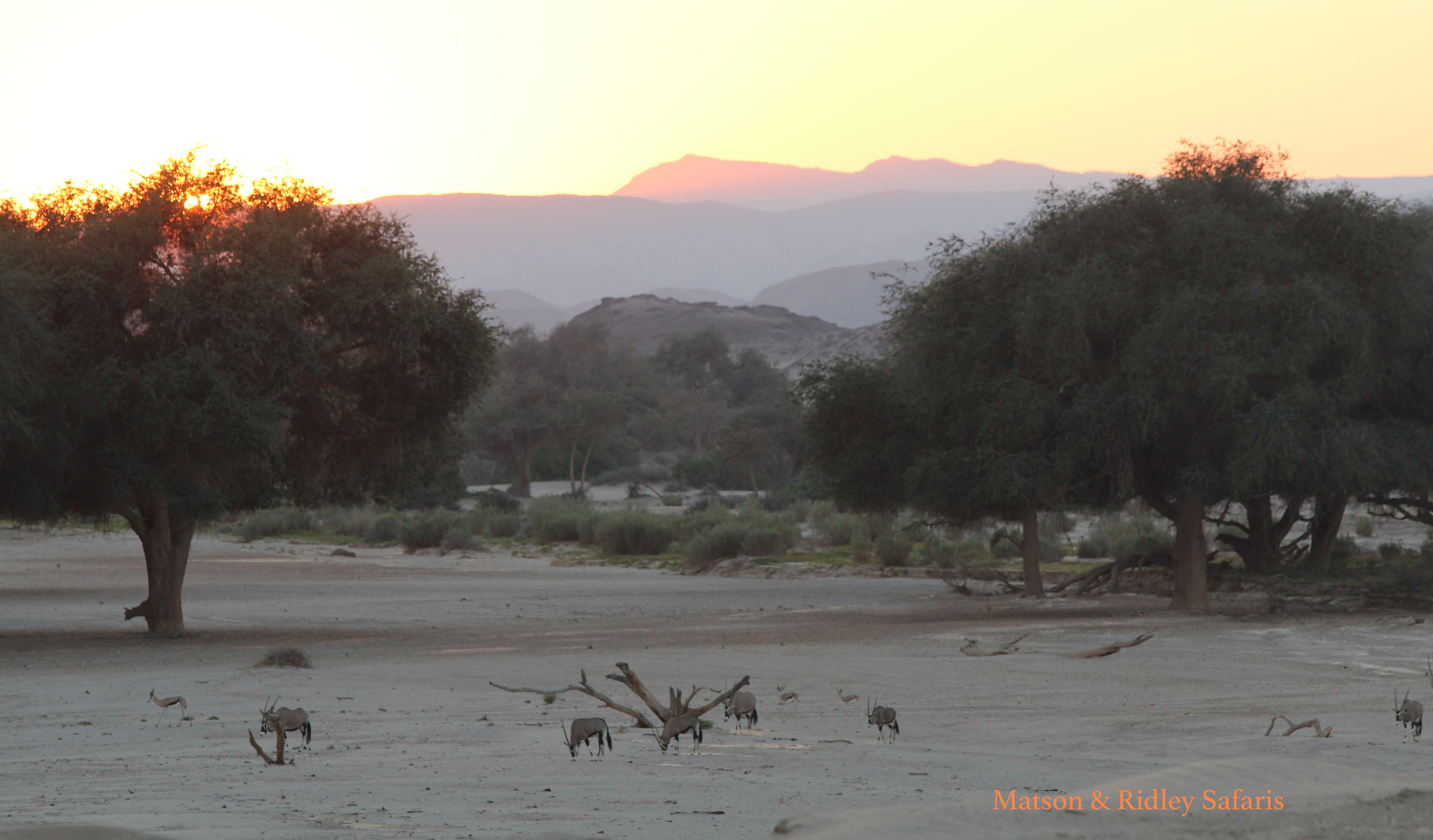
I love the dawn light in Namibia. There’s a short time where everything turns a rosey-apricot. Just before that time, all seems peaceful and cool, before the suns rays bear down on the desert sands. This photo of a herd of oryx was taken at sunrise in the Hoanib River. Just a few months earlier, this river had run, something very rarely seen in this neck of the woods. It had barely rained in camp, but there was more rain inland, enough to cause the river to run, and even a little rain makes a huge difference in arid landscapes.
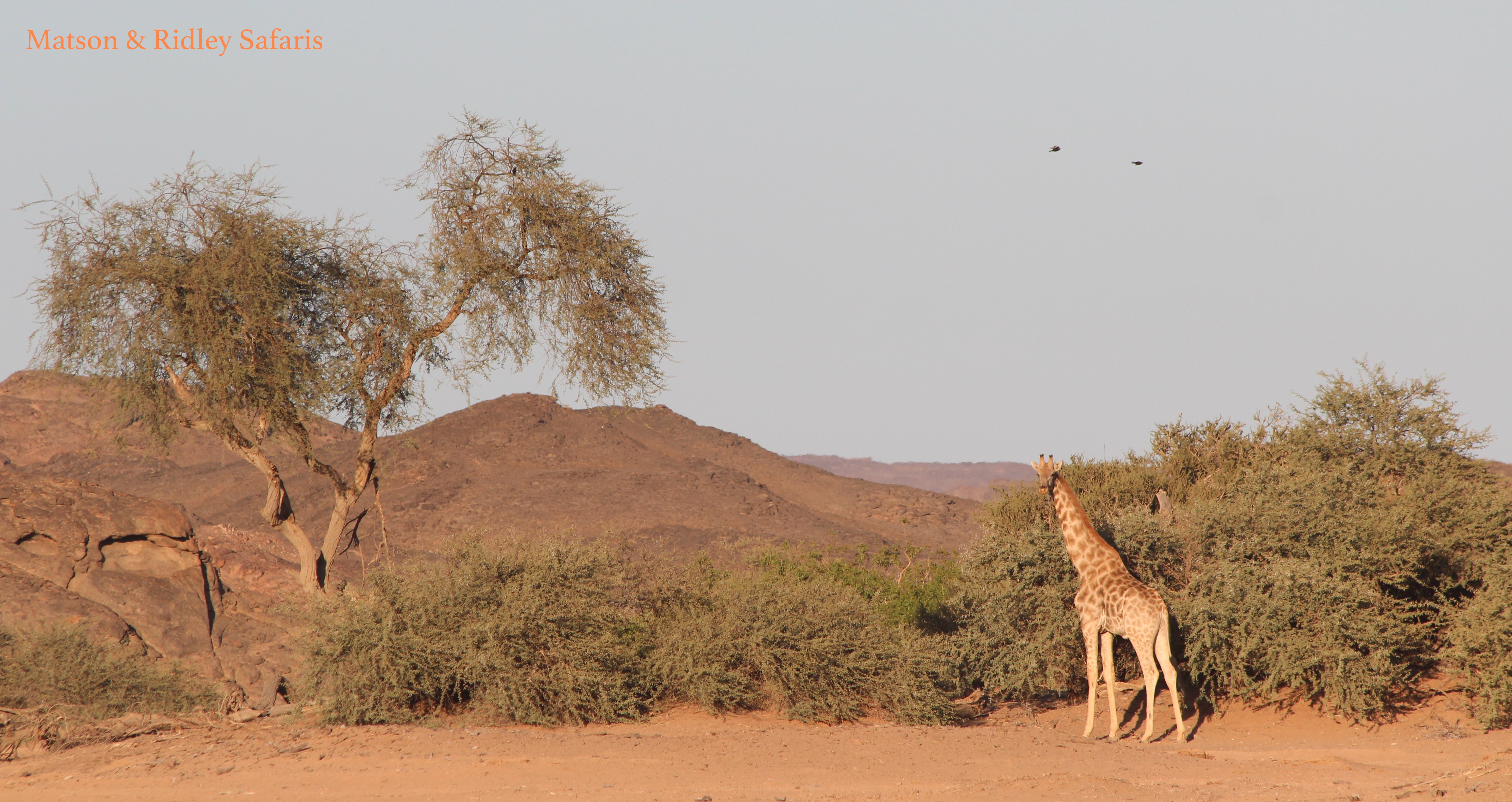
Desert-dwelling giraffes or desert lion-prey (depending on how you look at it!) are a frequently sighted species in the Hoanib River ecosystem. The tall, shady Ana trees (Faedherbia albida) that line the dry Hoanib River all bear browse lines at giraffe/elephant height and were providing a rich source of protein for many species with all their dropping pods when we were there. When you first arrive at Hoanib it’s like you’ve landed on the moon. You wonder how could anything live here with so little food and water? And then you go down into the river and you realise just how much life is there, and what amazing adaptations the animals and plants have to living in this hostile, arid environment. Our group loved hearing more about desert-dwelling giraffes from Dr Julian Fennessy on our last night on safari, and you can support the work of the Giraffe Conservation Foundation, one of the projects we at Matson & Ridley Safaris support, by checking out their website. And don’t forget 21 June is World Giraffe Day!
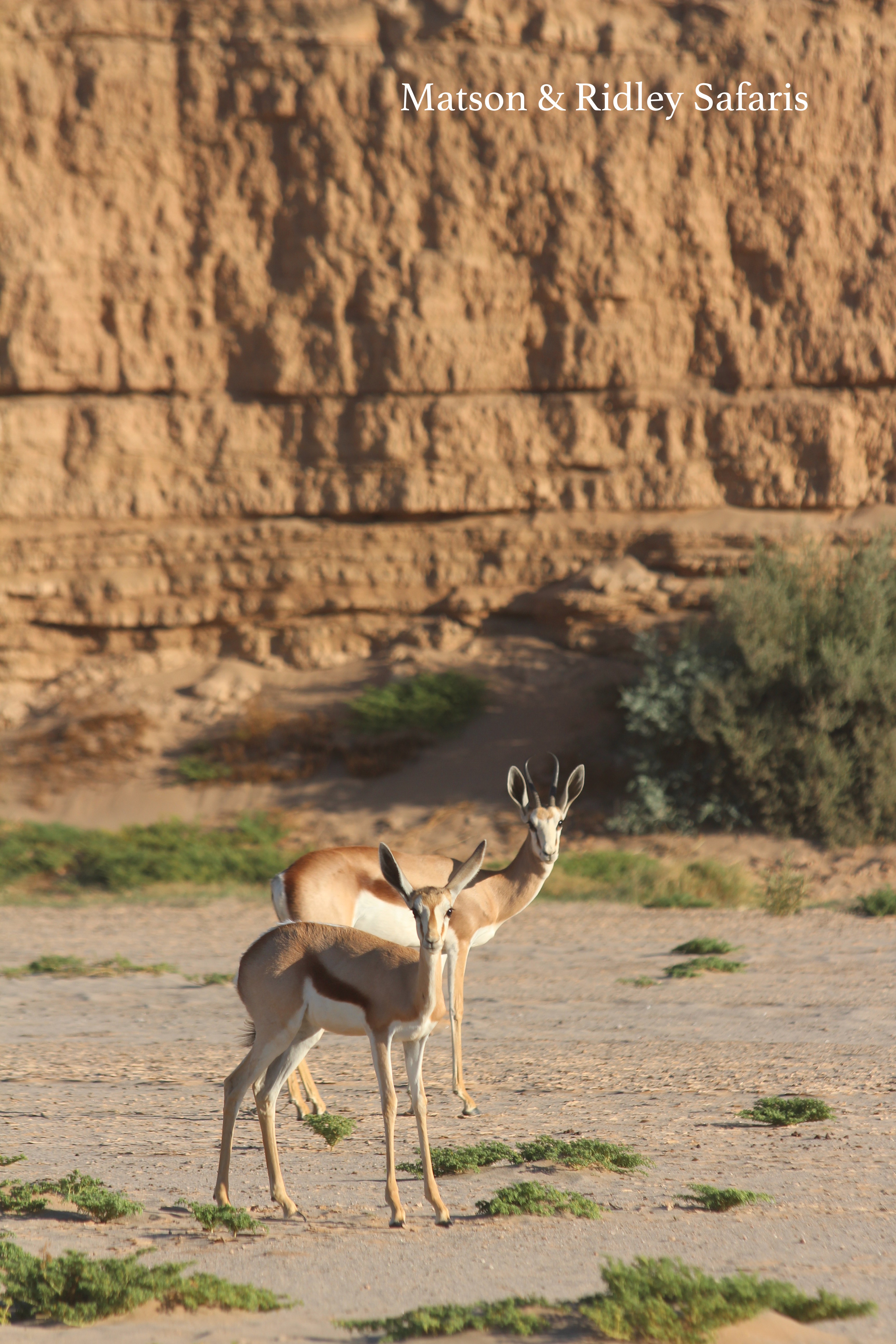
Springboks feast on freshly fallen pods of Acacia and Ana trees in the Hoanib River, as well as the water-filled ‘ostrich salad’ (seen here in the foreground). When the fog rolls in from the Atlantic Ocean about 60 km to the west, this replenishes the succulent plants that they eat, and so springbok rarely need to drink as they get enough water from their food. Unfortunately during our time at Hoanib the infamous ‘east wind’ prevailed on the coast, bringing very hot winds from the inland, preventing the fog rolling in from the ocean, and bringing temperatures up to almost 40 degrees Celcius in the sun. You can never predict the weather in this country! It was a fresh reminder to me that you always have to prepare for possible extreme heat and extreme cold in the desert.
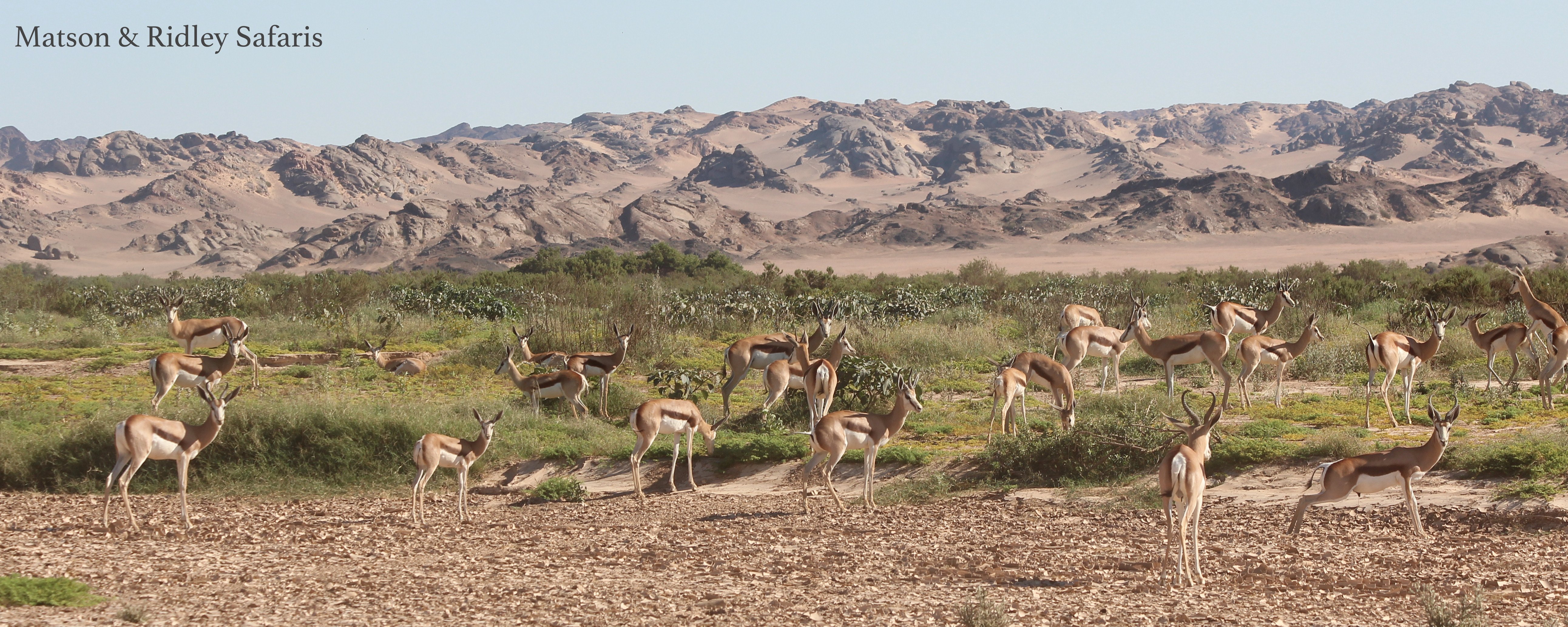
Springboks enjoying the green pickings while it lasts at the floodplain at the end of the Hoanib River near the Atlantic Ocean. Springbok are so well camouflaged in the desert and their white under belly allows heat to be deflected off the oven-hot ground as the day warms up.
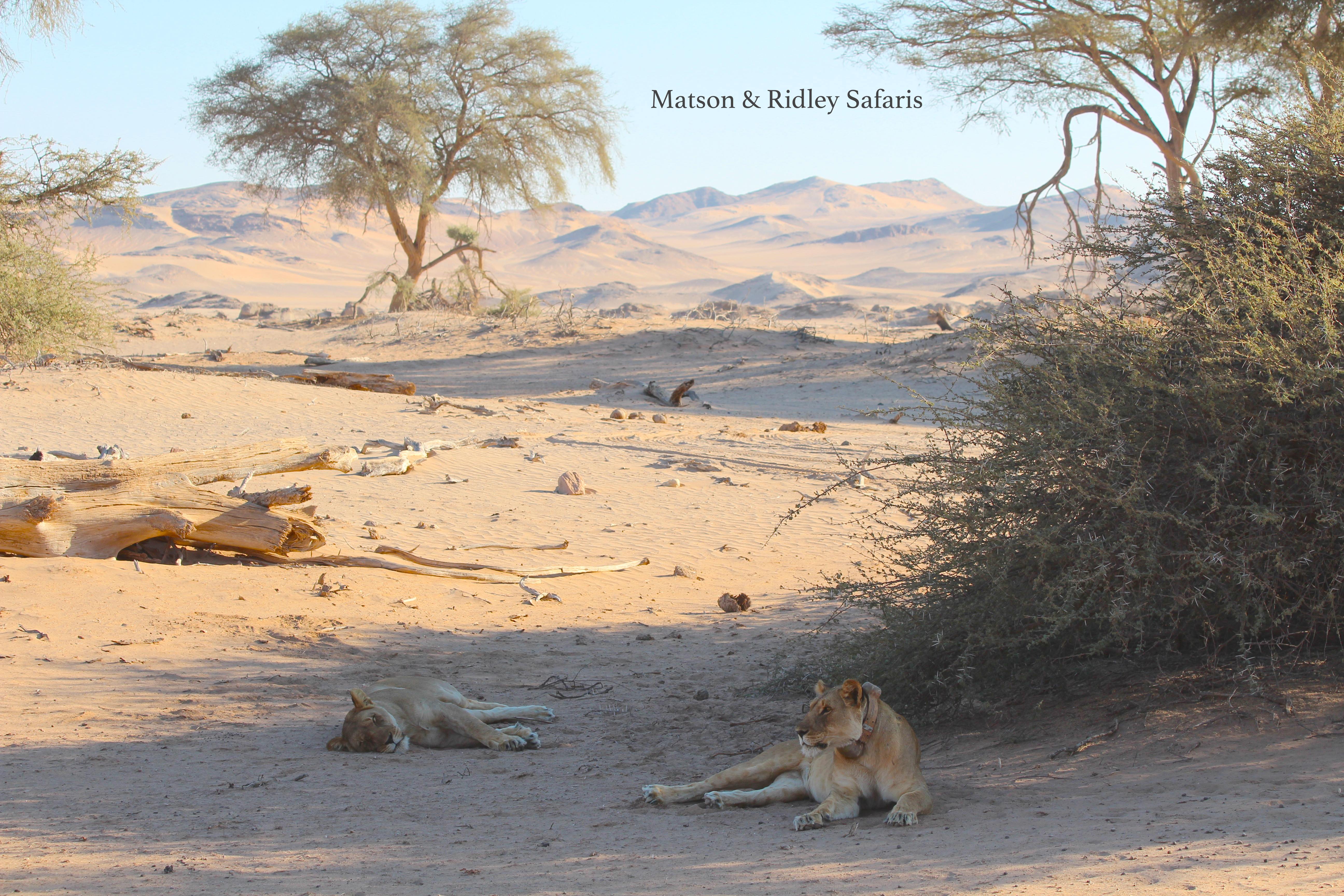
Just a few hours in to our drive to the Skeleton Coast, our Wilderness Safaris guides Elias and Liberty spotted fresh lion tracks. Searching for them on both sides of the river, following their tracks, we eventually found the two lionesses and 3 young cubs, lazing in the shade. The two lionesses are stars in the brilliant new National Geographic documentary, “Vanishing Kings“, and these incredible desert mamas provide for themselves and their offspring in formidable, harsh conditions. These lions are specialised giraffe hunters, no mean feat for just two of them. For a while there they were also feeding their 5 almost grown up sons! The desert-dwelling lions in this area are part of a long term study by lion expert Dr Philip Stander. They have huge home ranges and often must walk a very long way to find food in these arid conditions.
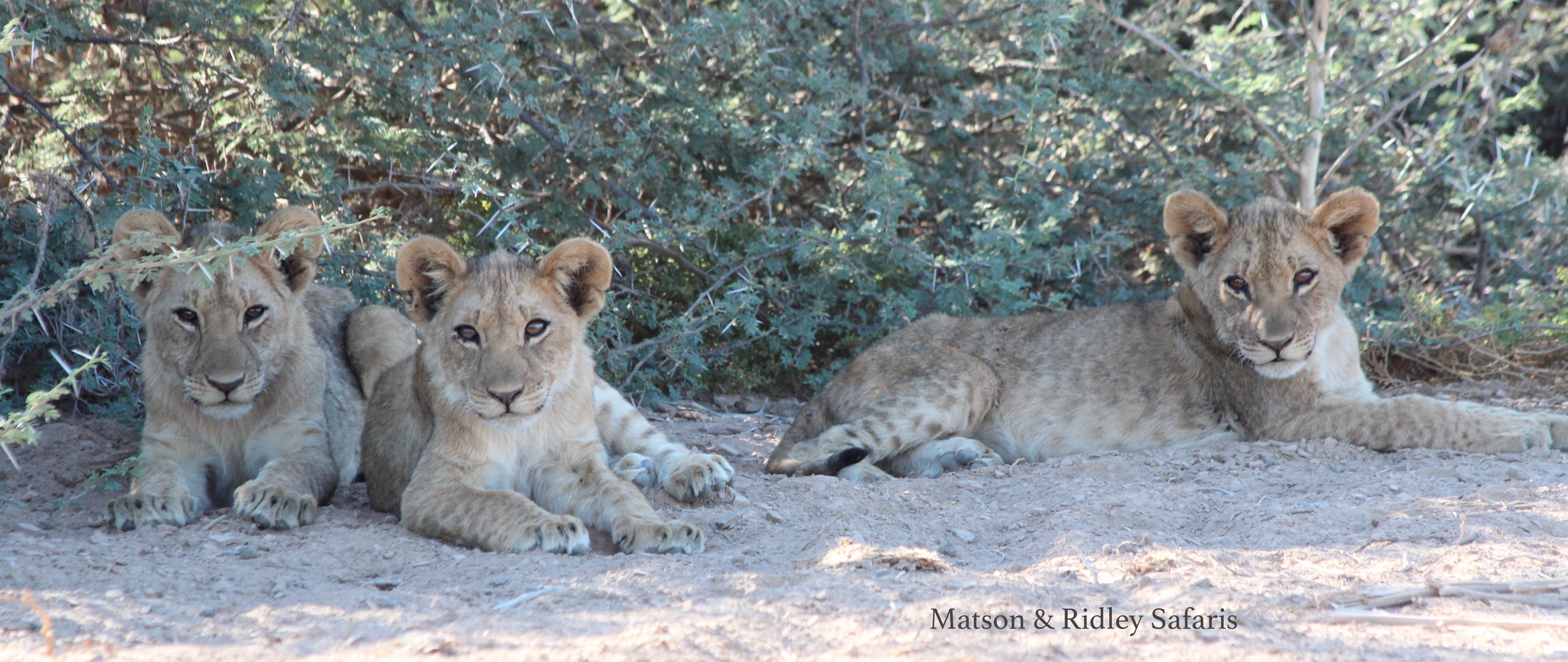
The next generation of desert-dwelling lions is crucial to the survival of this population. Desert-adapted lions often move out of protected areas and come into contact with people and their livestock in rural areas, creating obvious conflicts with local people who consider their cows to be the equivalent of money and status. They can be shot or poisoned by farmers who do not want them threatening their cattle. While we were there, the ‘five musketeers’ (the 5 lions who are the offspring of these two females, now fully grown) had wandered up to Purros Conservancy and out of the safety of the park, creating concerns among the staff at Hoanib Camp. We wondered what the future held for these 3 small female cubs. A fourth cub, their sibling, had been washed away in the January flood. At least with the two lionesses teaching them how to survive, they have great examples to follow.
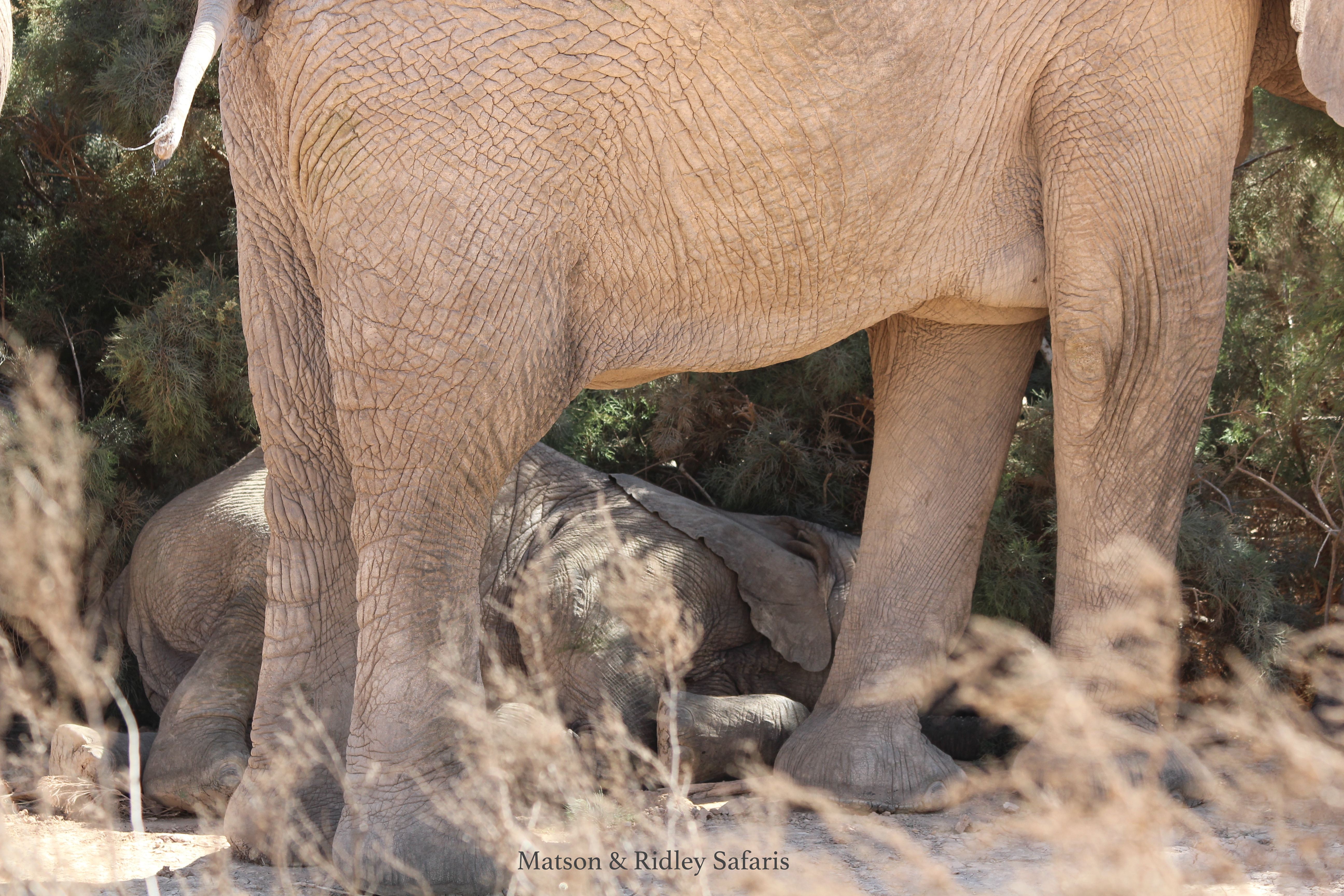
When a baby elephant lies down beside its mother right beside you, you know it’s feeling pretty relaxed. It’s a privilege to see this. In other parts of Africa, elephants can never relax due to the presence of poachers for the ivory trade. This herd of desert-dwelling elephants move up and down the Hoanib River, feeding on the Ana trees and other shrubs along the length of the sand river. We all enjoyed the ‘elley-therapy’! Note the wide feet of the desert-adapted elephants, suited to sliding down sand dunes and walking on sand over long distances.
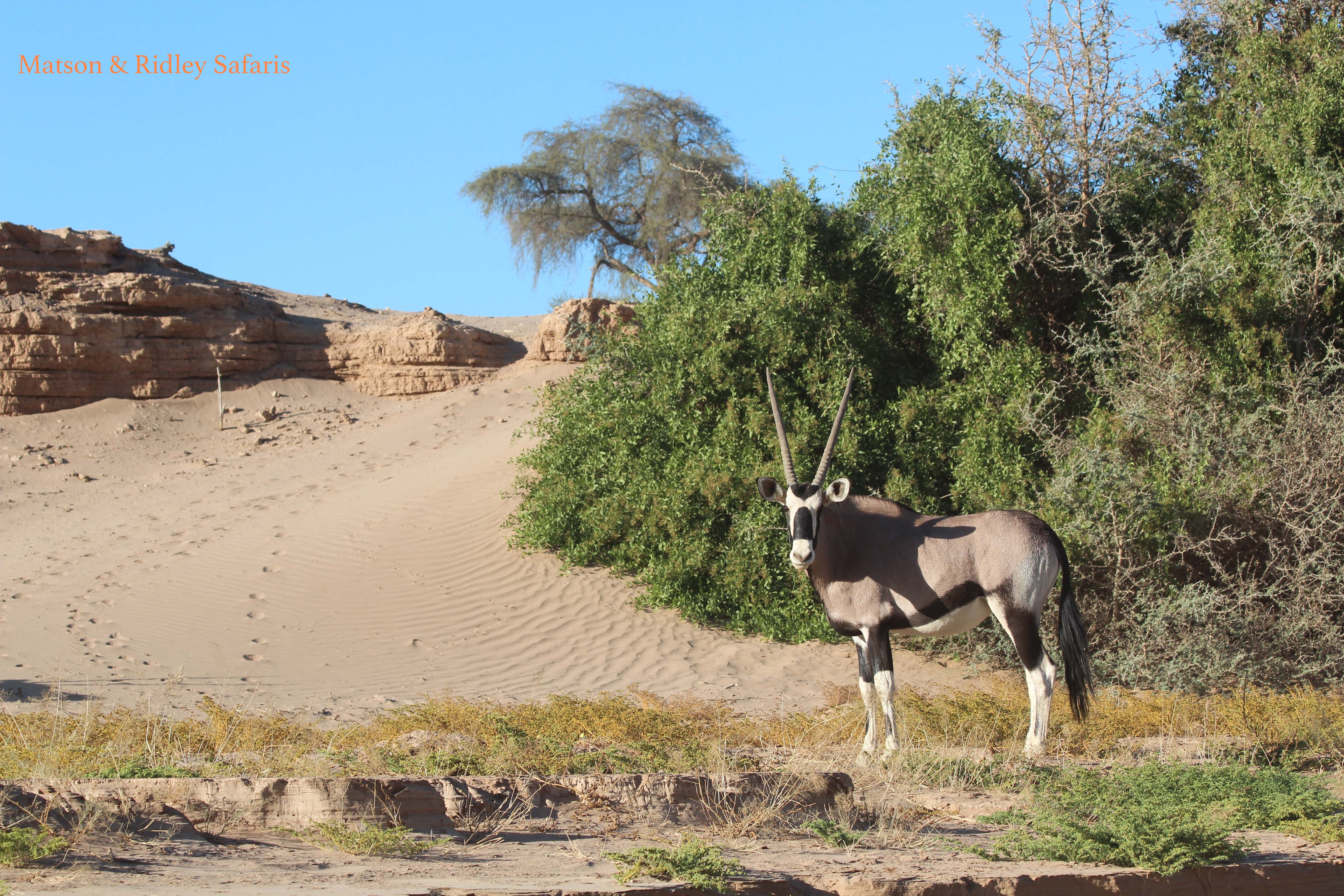
Oryx antelope – one of the most regal of all the antelopes, and the perfect desert survivor. Note the white underbelly and white on the lower legs for reflecting heat. The oryx practices nasal panting, which prevents the brain from overheating when standing in the desert sun at extreme temperatures. Like the springbok, they barely ever need to drink, gaining enough water from their food.
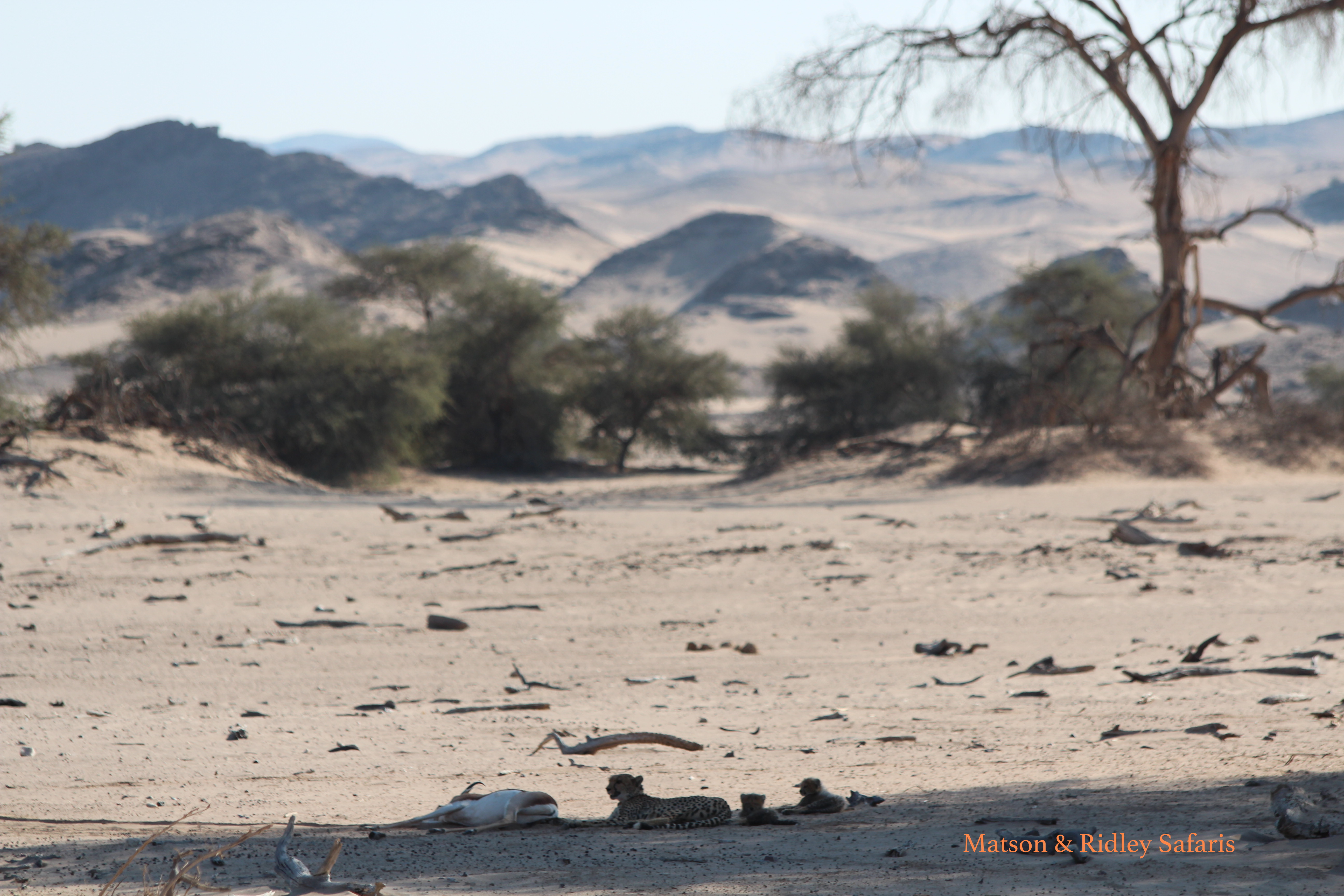
This is something you don’t see every day! The photo isn’t the greatest but this was a rare sighting indeed. It started with our guide Elias spotting fresh cheetah tracks in the sand, but you could tell there were predators around as there wasn’t much game around this area. Then Leonie spotted her – a cheetah mother with small cubs! We kept our distance, giving her space, as with young cubs she was more wary and we didn’t want to spook her. And then as we patiently sat there, she crouched down and became very interested in something in the river. It was a male springbok. Well now things were about to get interesting. It’s one thing to see a cheetah in this environment, but quite another to see one kill a springbok, with two cubs running along behind her! It took the female almost half an hour to cool down after making the kill and dragging it into the shade. The two cubs were impatient to eat, tugging on the ears of the springbok and trying to open it up (without success!).
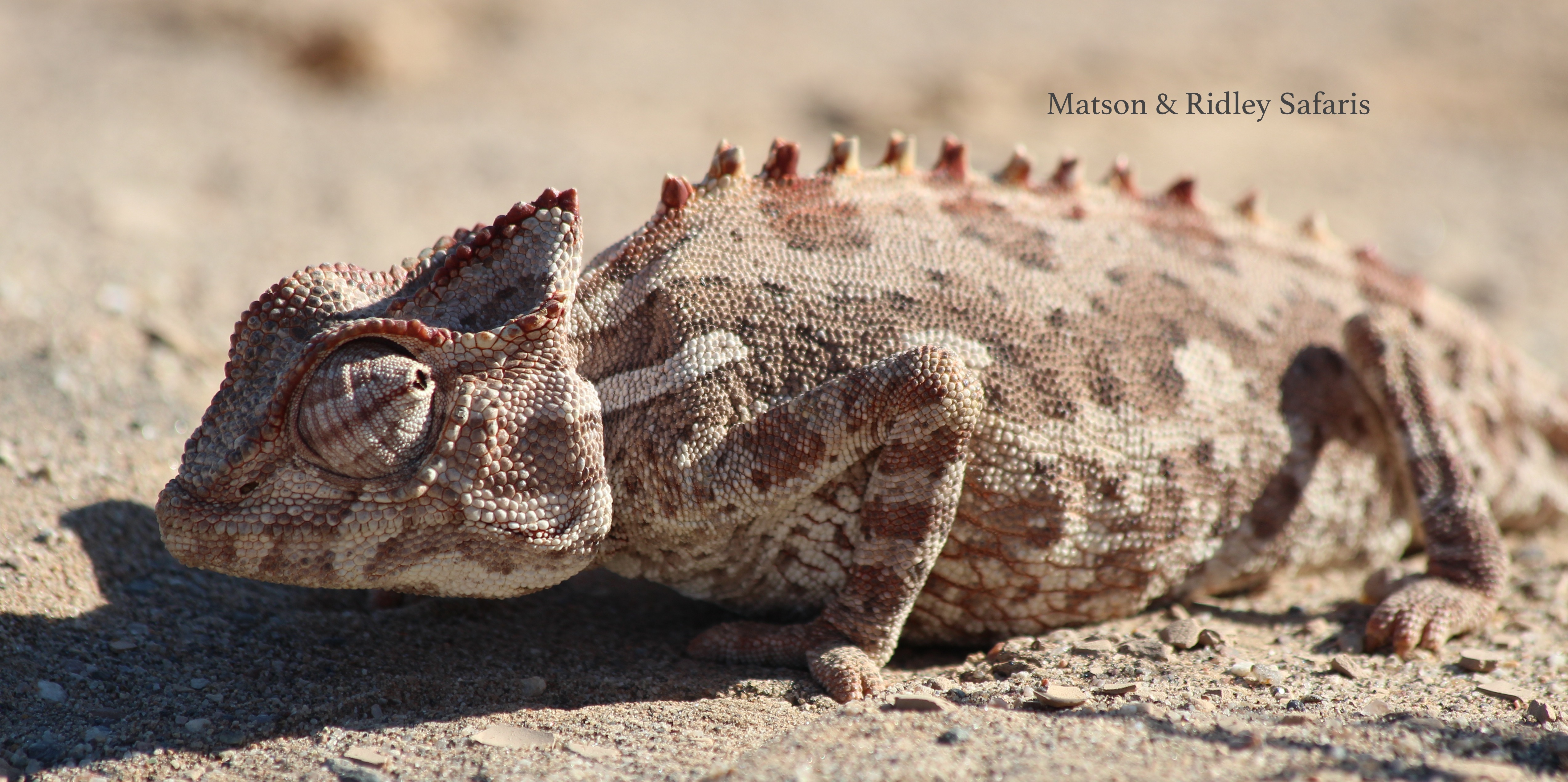
If I didn’t know better, I’d never have known this chameleon was heavily pregnant with eggs, but you can see from the size of her belly. She was on the road, and our guides kindly surrounded her with big logs to stop other guides driving over the top of her. Below you can see the eggs she had just laid, something I had never seen before. In fact until this day I never even thought about how baby chameleons arrive in the world, so now we know!
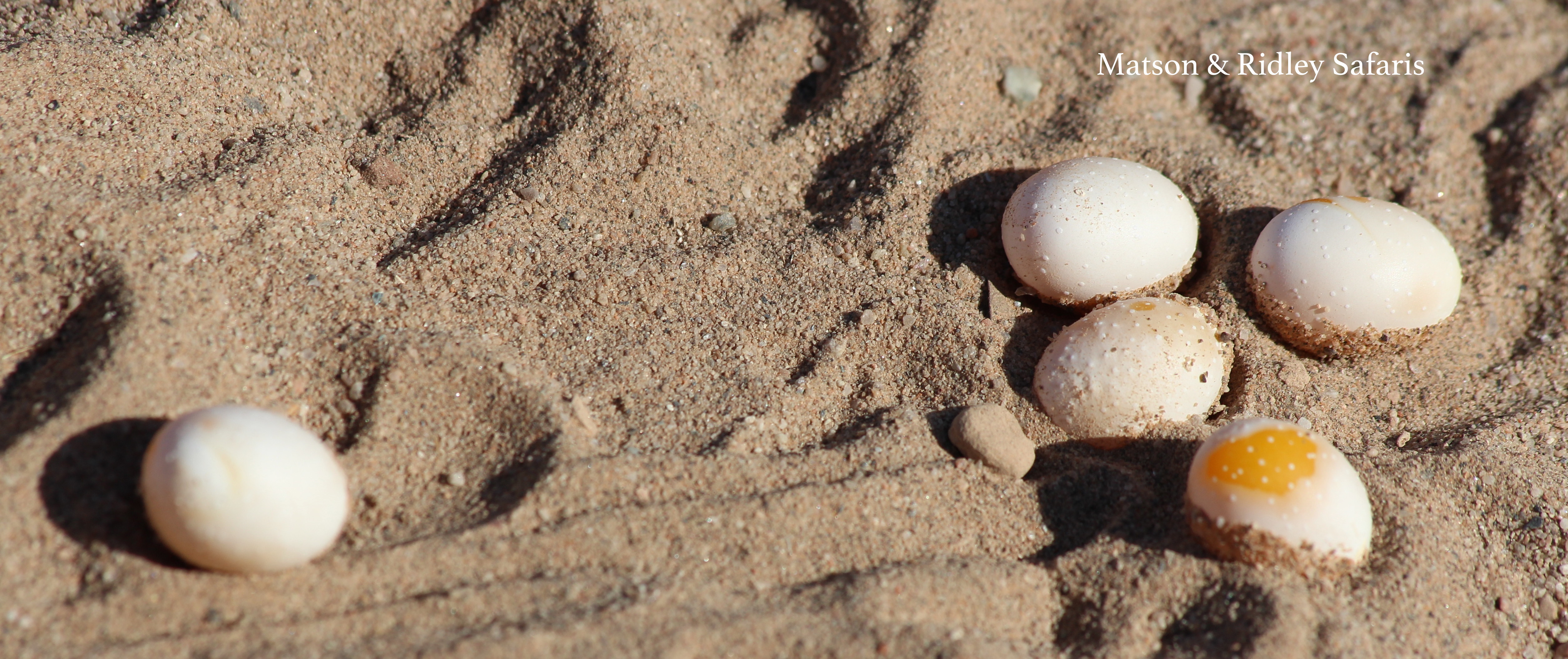
Eggs of said chameleon above. The guides told us she would bury these once we left her alone. What a thrill to witness this!
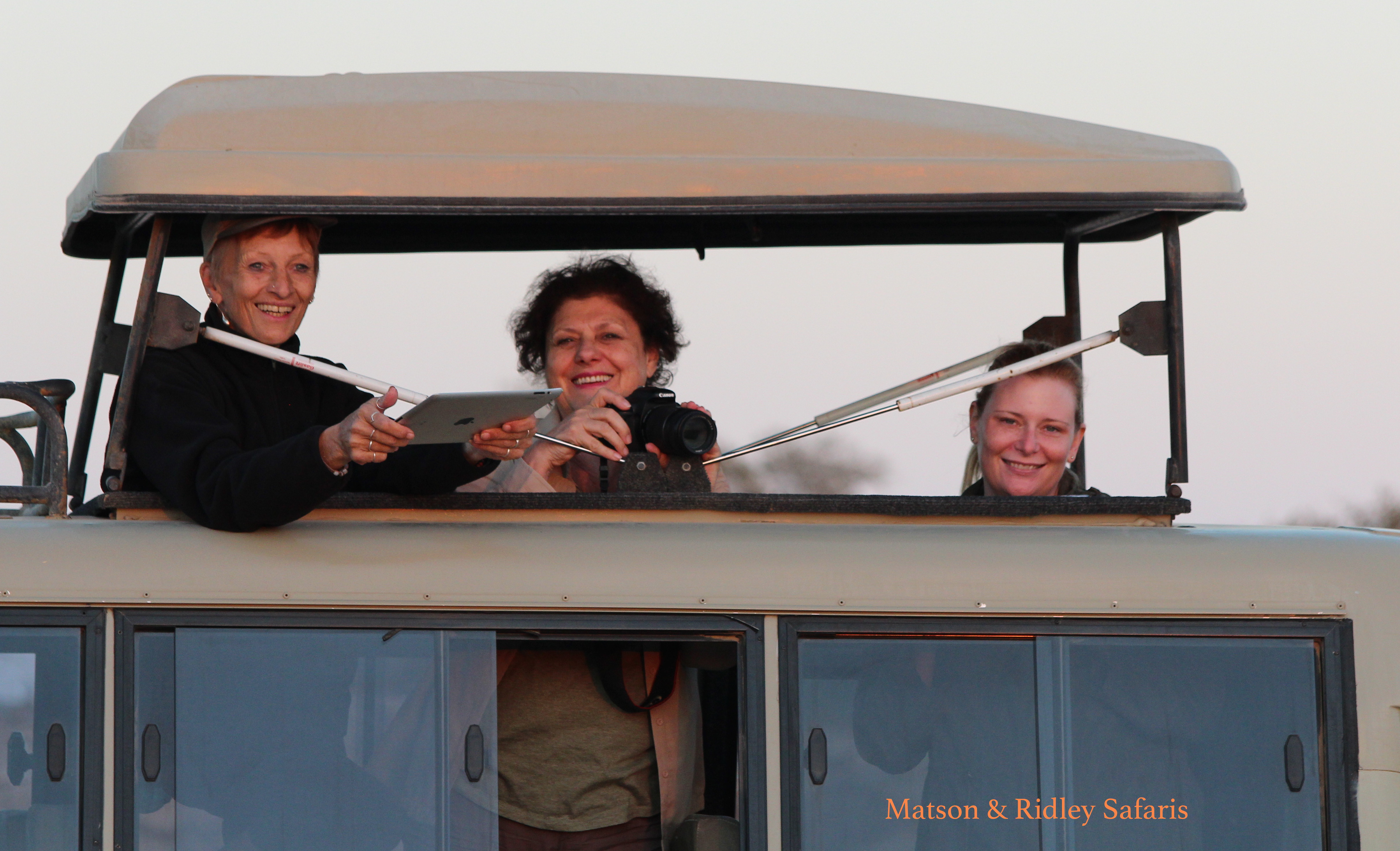
Maggie, Leonie and Joanne, ‘the Aussies’, watching the sun rise in the Wilderness Safaris land cruiser. We had everything from Canon and Nikon SLRs to iPhones and iPads in our collection on this trip. Helen brought along a new 600mm lens for her Canon SLR which really gave a good view of the wildlife, especially the kills. I had my 100-300mm Canon SLR which I used for all of these photos. I’m looking forward to seeing everyone else’s best shots. Post them on our Matson & Ridley Safaris Facebook site if you like!
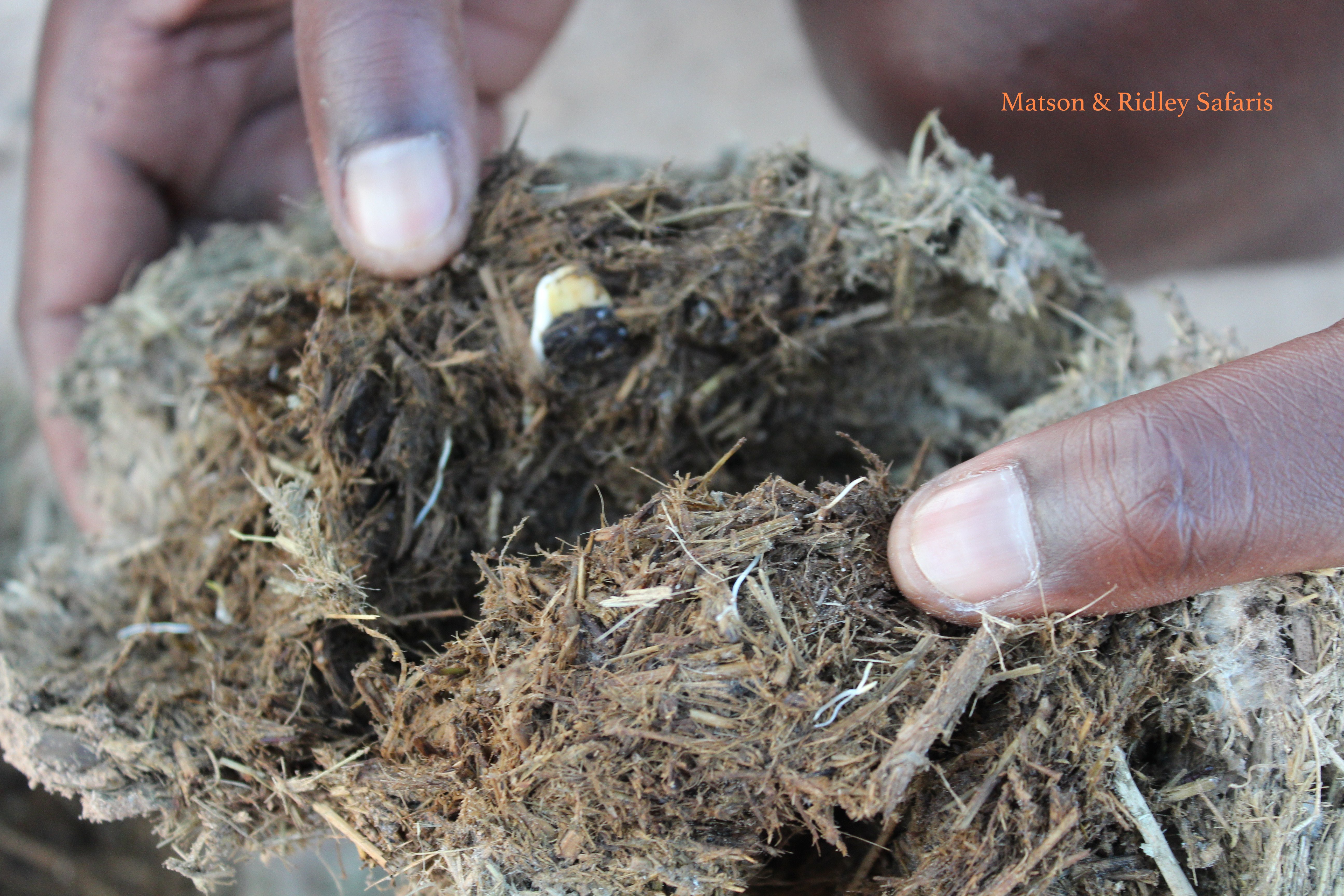
On an afternoon walk, I opened up a ball of elephant dung that was still wet inside and discovered fresh seedlings of Ana trees. I often talk about how elephants distribute seeds through their dung and it was very cool to see the seedlings literally germinating inside this dung. Elephants are keystone species and the whole ecosystem depends on them.
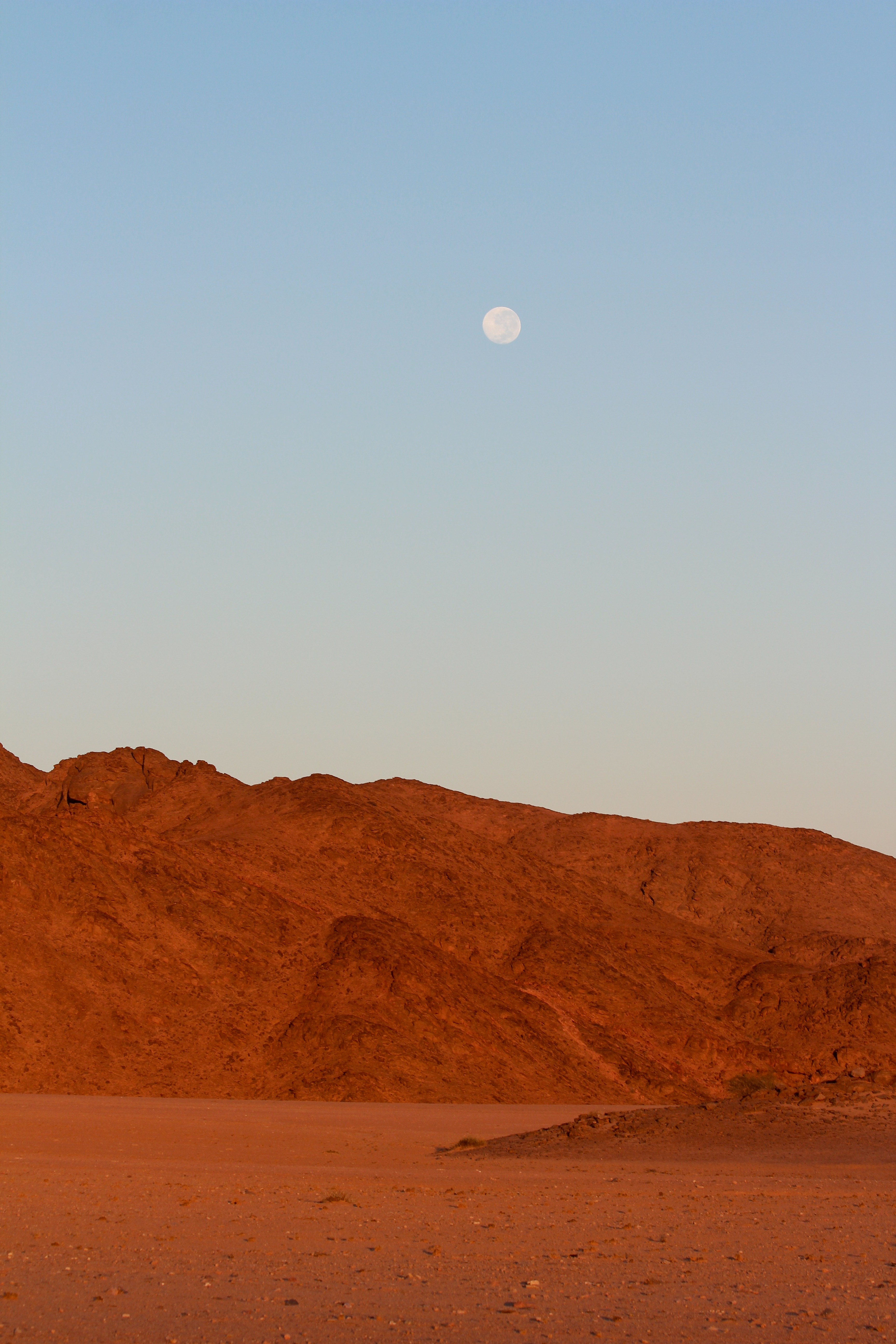
Dawn light is so amazing in the desert, although fleeting, and the full moon while we were there made for a really striking sight. A big ‘awww’ moment! It’s the landscapes and the space that make Namibia so amazing. It’s a place to leave your mobile phone behind and just reconnect with nature and yourself.
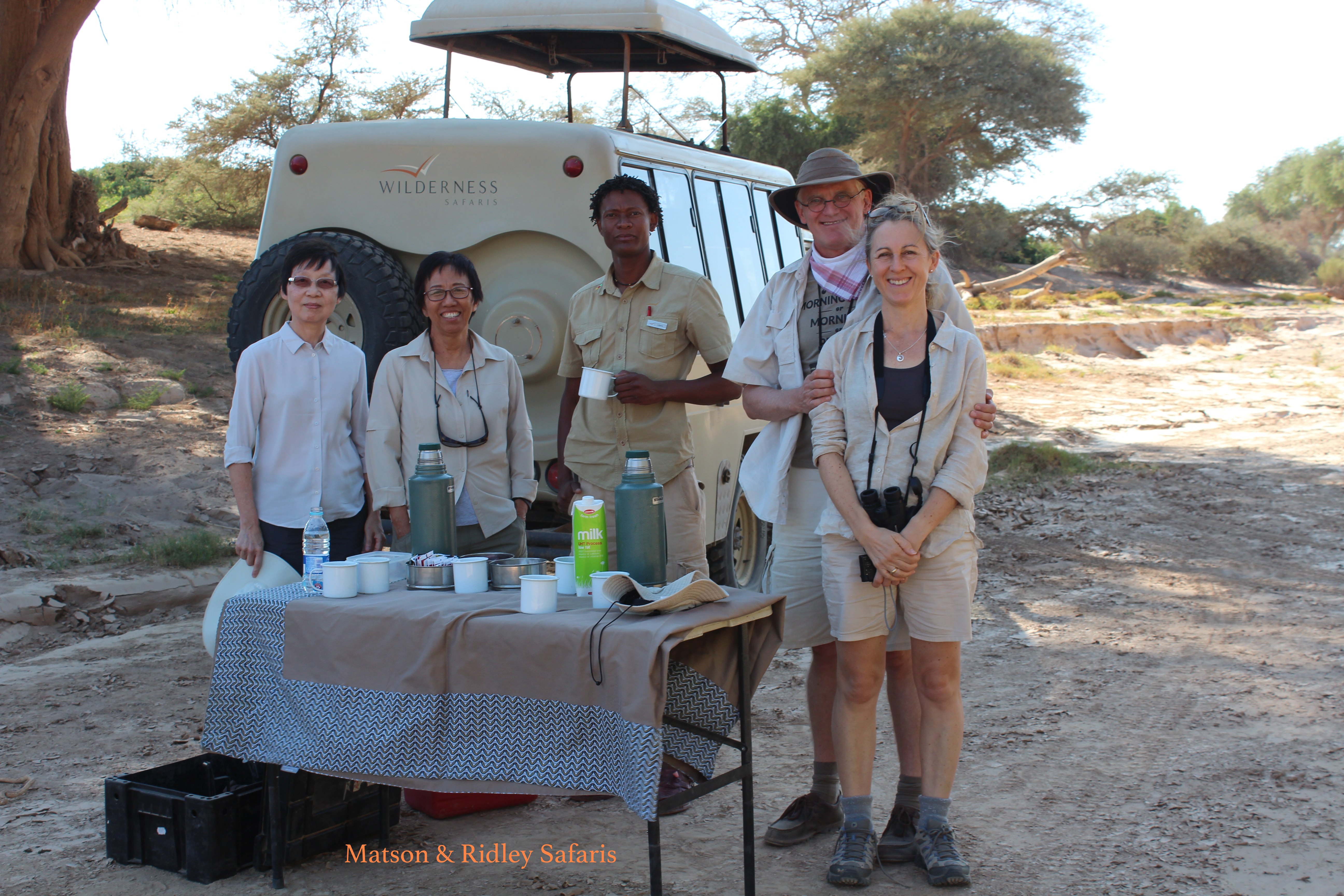
Tea time in the bush is always welcome. By mid morning, when you’ve been on a game drive since dawn, it’s definitely time for a cup of Five Roses South African tea and a home made biscuit, as well as a trip to the bush loo (after a quick check for puff adders and western barred spitting cobras). Here we pulled up in the Hoanib River bed, making sure that we were far enough away from the lionesses! Left to right: Patricia, Chuan Fong, Liberty, Tristan and Carina.
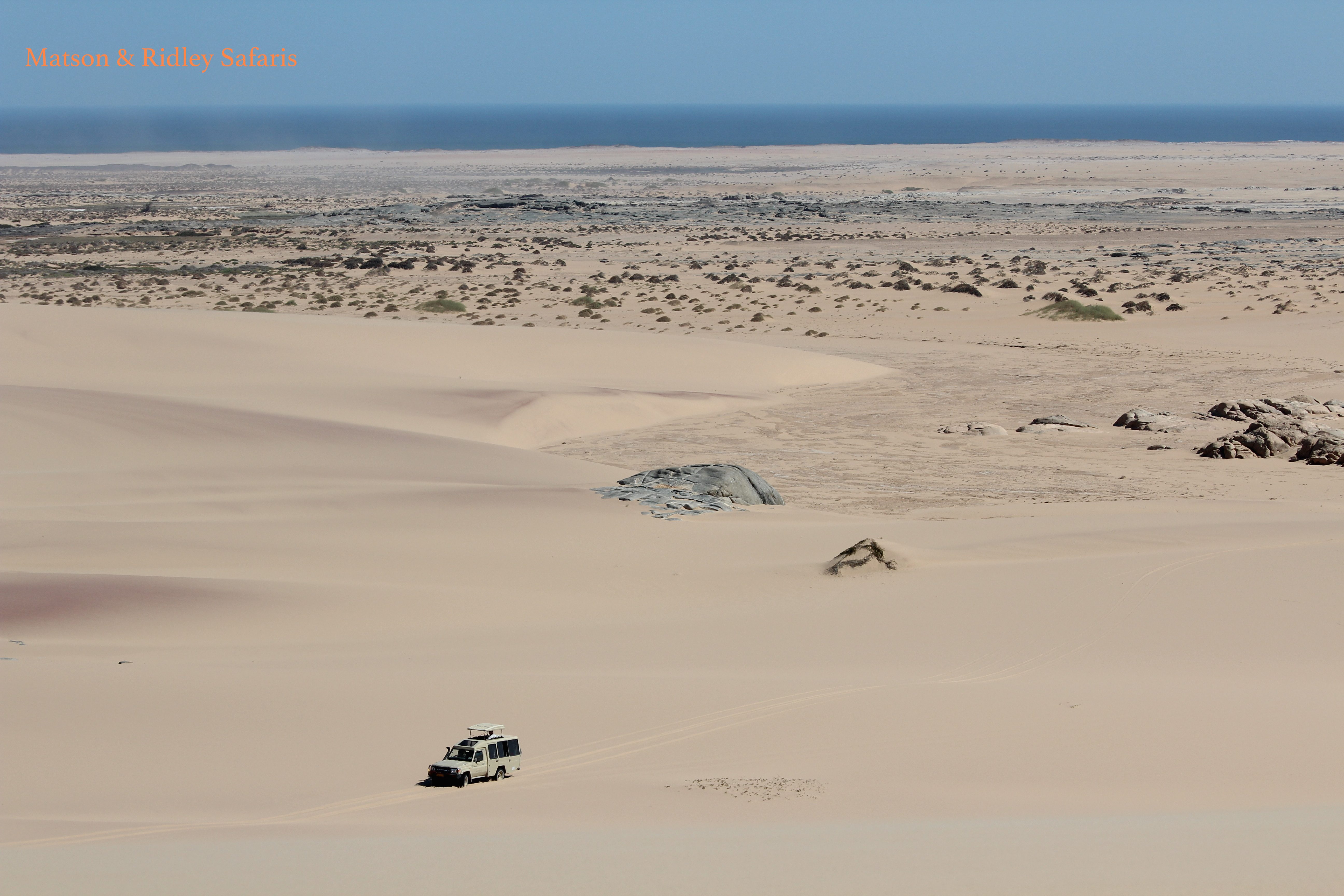
That first sight of the Atlantic Ocean in the distance as you cruise through the dunes through the Skeleton Coast is breath taking! This fragile ecosystem survives due to the fog, which creates moisture in an otherwise arid ecosystem.
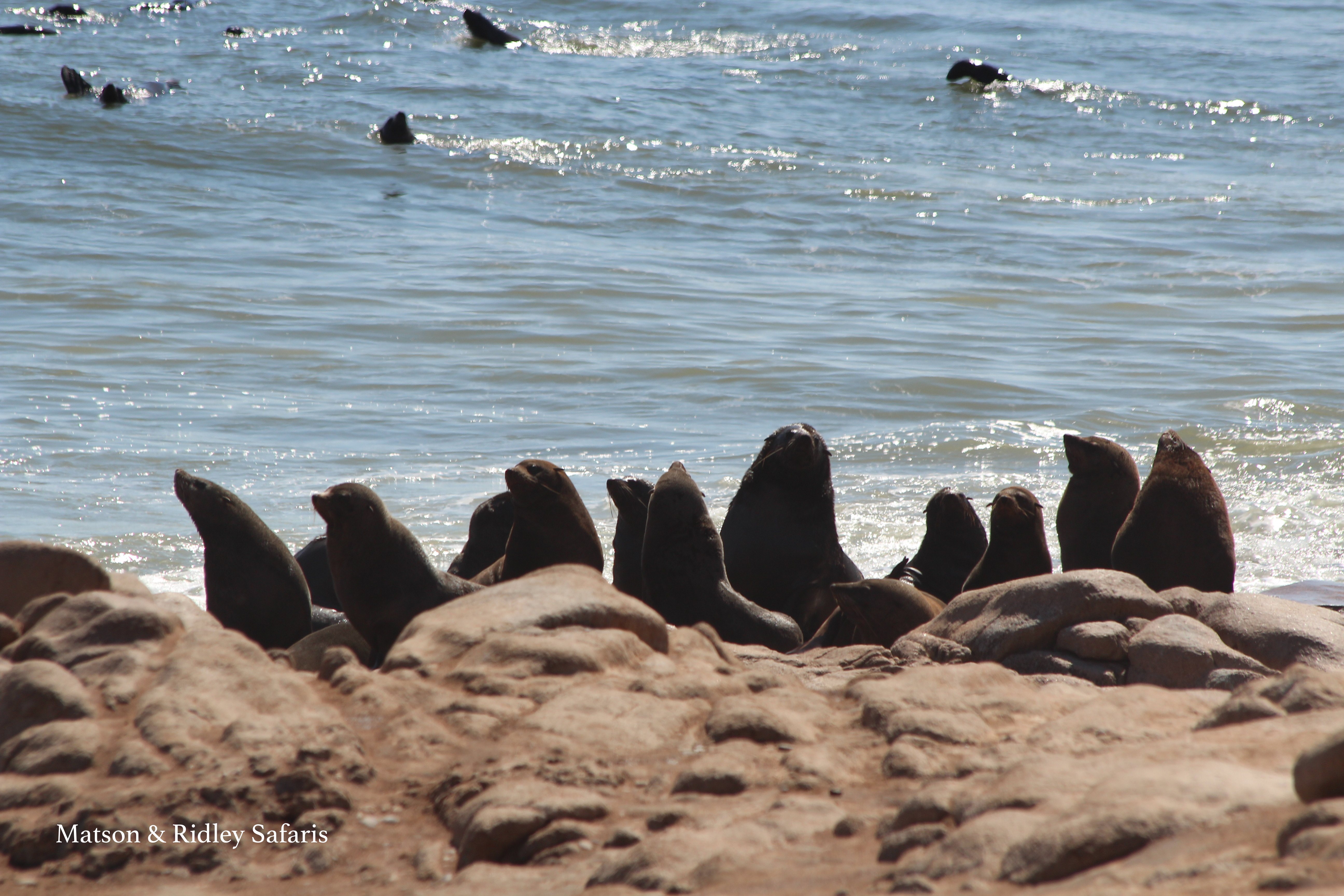
Cape Fur Seals form large colonies along the Skeleton Coast line and provide food for brown hyaenas and jackals (and sometimes lions). Lots of them were in the water on the day we visited, due to the East wind making it so hot on land. This photo was taken just near Merwe Bay.
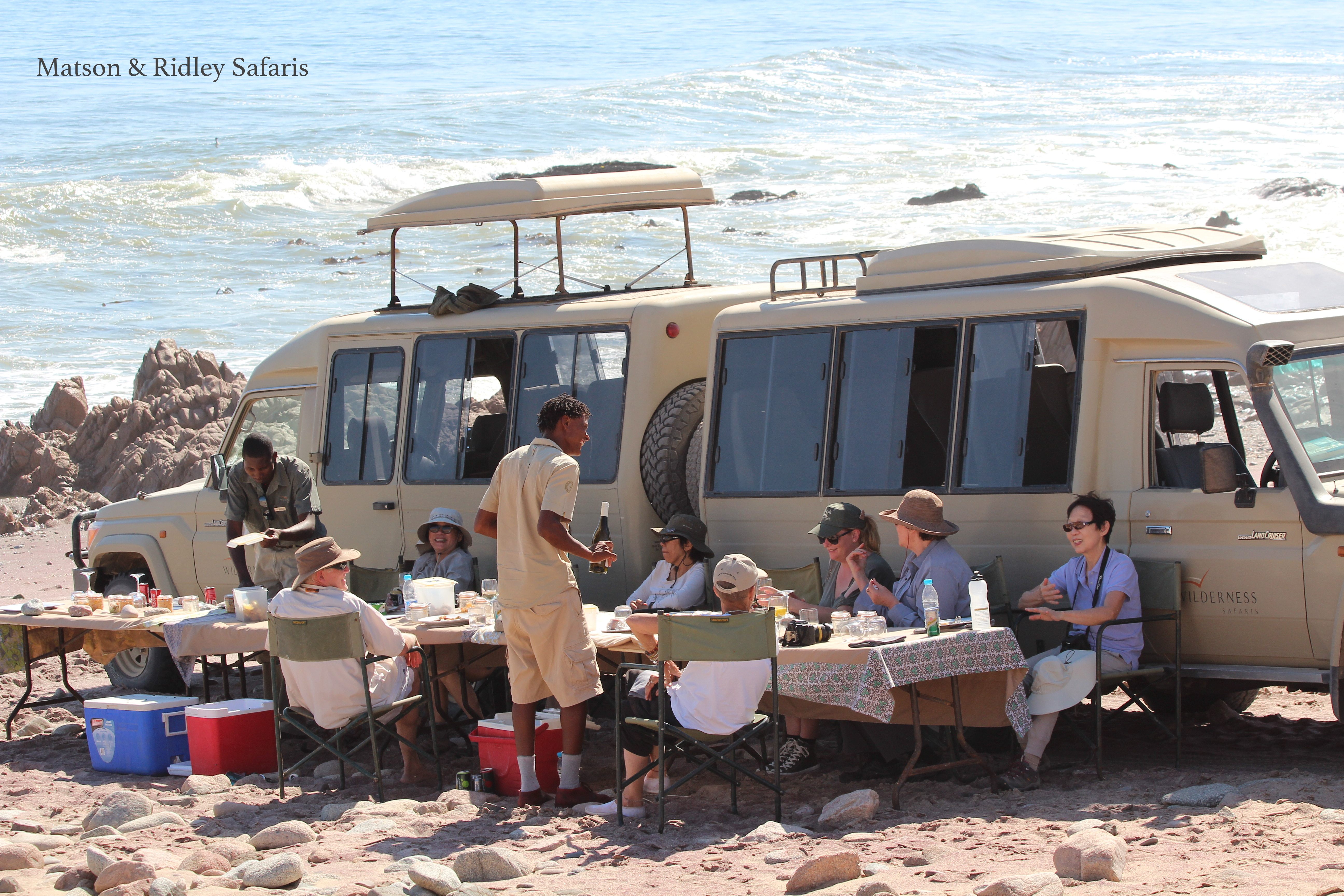
A much needed bit of shade beside the Land Cruisers was taken advantage of during a desert lunch and a wee drop of some fine wines.
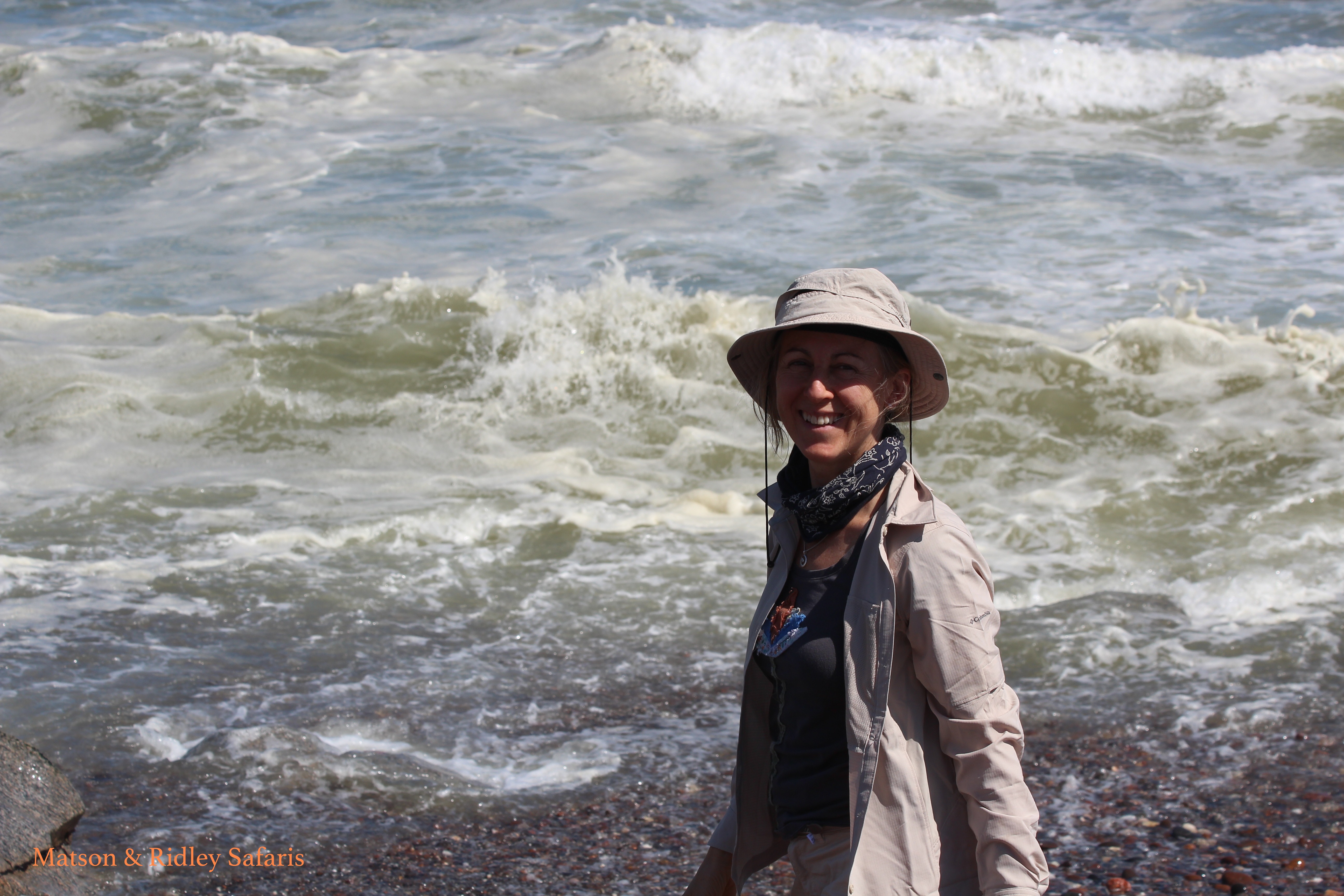
Carina by the sea…. The energy you get when hitting the sea after a long drive through the dunes is something else!
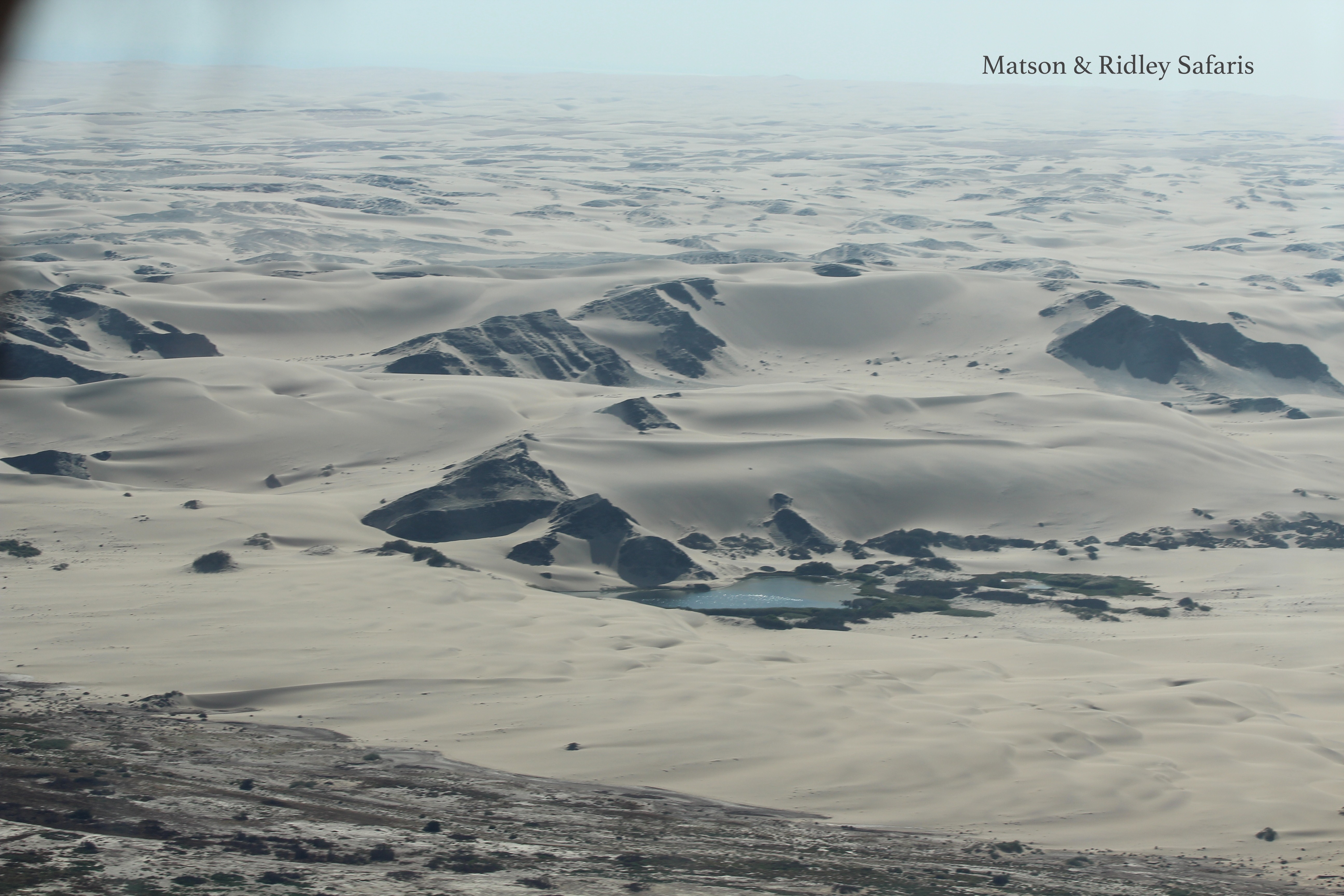
Something you rarely see – water in the desert dunes! This photo was taken from the plane on the ride back to Hoanib Camp. After the flood in January, there are still some waterholes left, creating amazing desert oases at the Skeleton Coast. This water will deplete and it could be another 5 years before the Hoanib sees another water flow.
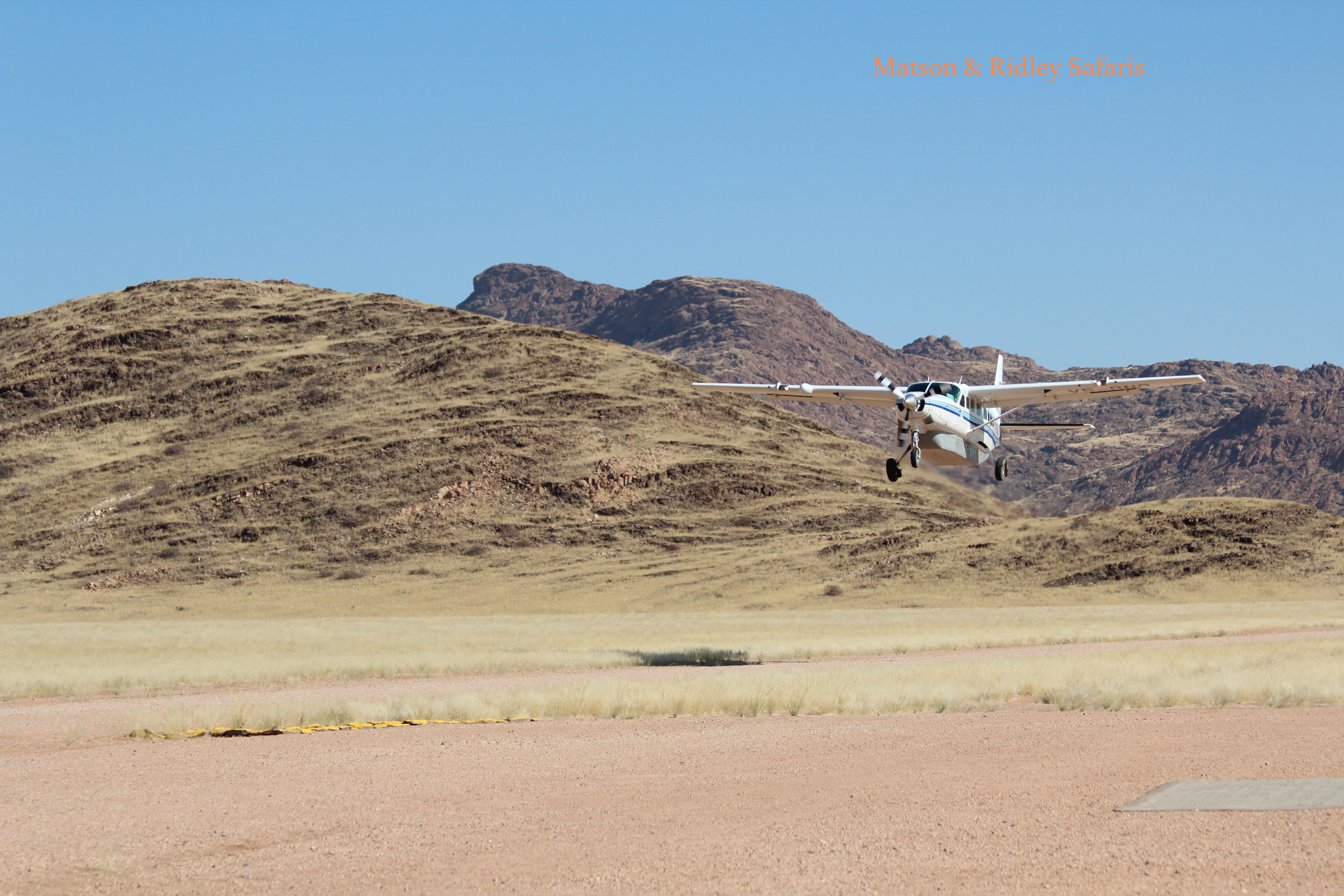
After 3 days at Hoanib Camp we set off for Serra Cafema, an hour’s flight north on the border of Angola. I’ll be blogging out it, with some incredible photos of this region and its traditional people, next week. Here’s a sneak peak, below…. And more photos coming at our Facebook page, so please like us at Matson & Ridley Safaris on Facebook to see them.
Limited Places Left on my 2016 Safaris (& a sneak peak at my 2017 safaris!)
I’m getting very excited about my upcoming safaris in 2016, which are set to be in some of Africa’s most spectacular wilderness areas! As always when you book with Matson & Ridley Safaris, the whole experience are specially hand-designed by me every step of the way to ensure that your hard earned dollars are spent as ethically as possible, to maximise benefits flowing back to African people and their wildlife. And of course, I choose the areas and camps I want to go to based on the best I can find in terms of wildlife experience, exclusivity, camp feeling and local culture – so you get a mind-blowing African journey that will change your life. Most groups I take are between 8 and 12 people, so you get to know people really well. Imagine yourself spending time with like minds on the savannah while watching elephants and then spinning a few yarns under the starry night sky by the campfire later – life doesn’t get much better really!
I have a few spots for my safaris left in 2016, but don’t wait to grab your spots as these have to be booked this year.
Kenya’s Maasai Mara in the green season, including a private visit to Daphne Sheldrick’s elephant orphanage
20-27 Feb 2016.
Up to 7 places left, but time is very limited to sign up for this trip as you only have until THIS FRIDAY! Check out my photos from last year’s trip. An unforgettable journey – I can’t recommend this area highly enough!
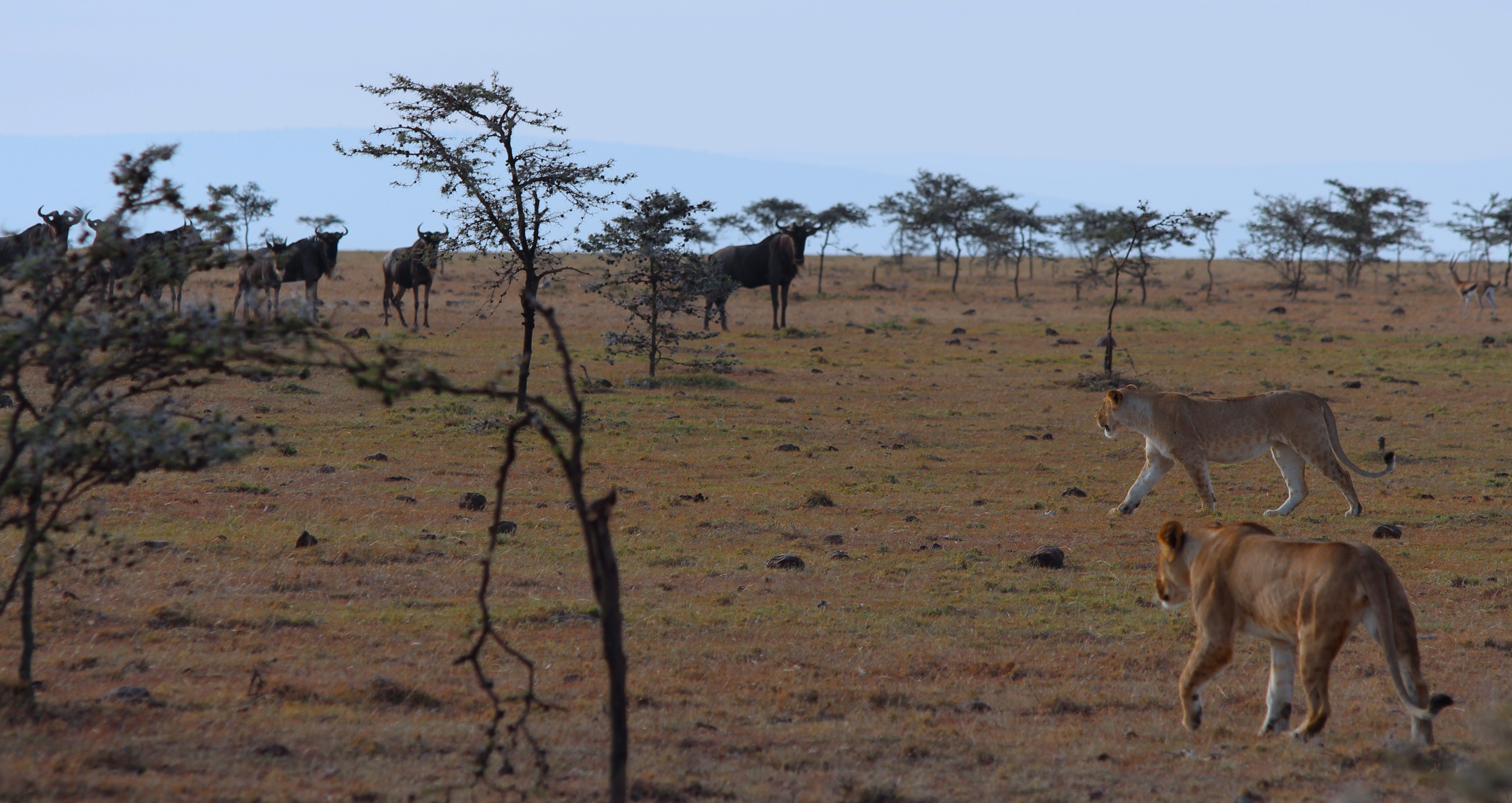
Lions thinking about chasing some wildebeest – a virtual buffet in the Maasai Mara (photo: Tammie Matson)
Namibia’s Skeleton Coast – Himbas, desert elephants & dunes!
20-27 May 2016.
Only one spot left for a single female!! Check out my photos from this year’s trip to Namibia.
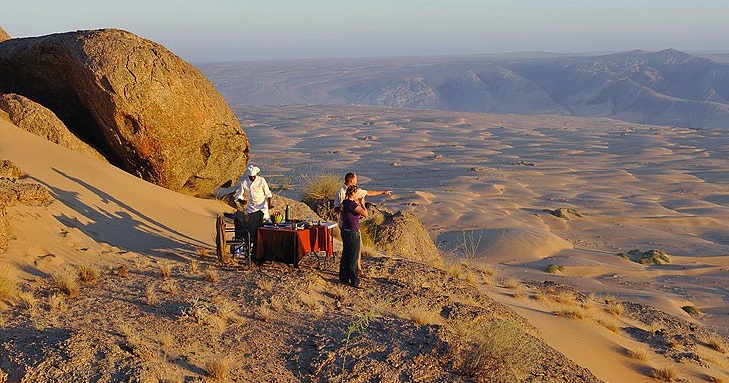
North West Namibia – one of the greatest wilderness areas left in Africa (photo: Wilderness Safaris)
Zimbabwe – Hwange, Mana Pools and Victoria Falls!
23-30 September 2016.
Only 3 spots left! This trip is different to the one I advertised previously as it focuses only on northern Zimbabwe. We are going to some of the most wildlife rich areas in Africa – an unbeatable nature experience at some of the most gorgeous camps in the country. Contact me for the itinerary.
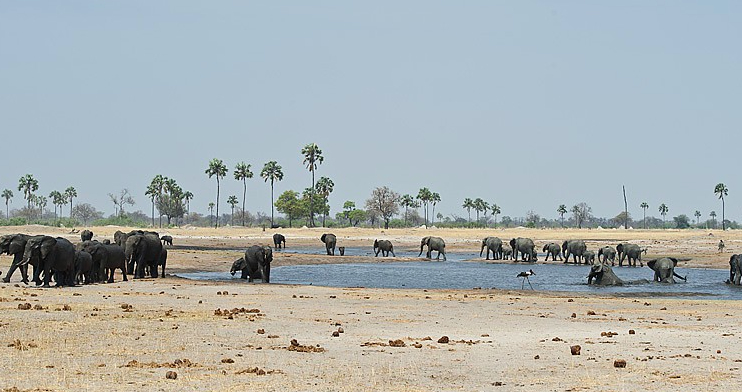
Elephants congregate in abundance in Hwange National Park, Zimbabwe – one of my favourite parks in Africa (photo: Wilderness Safaris)
My 2017 Safaris
Shortly I’ll be releasing the details of the conservation safaris I’ll be leading in 2017. I can share at this stage that there will be two back-to-back ethical safaris that you can join either one of or both during August 2017. The first, starting on 8 August 2017, will be to Rwanda to experience the incredible Mountain Gorillas up close and personal. The second starting 5 days later, is in Tanzania, exploring the great plains of East Africa’s Great Rift Valley, first at Ngorogoro Crater and then onto the world famous Serengeti, during the height of the wildebeest migration. There will be an add-on adventure at the foothills of Mount Kilimanjaro for those who are keen to continue the journey after the Serengeti! Full details of both of these adventures will be in a blog very soon, but do drop me a line if you’re keen to register your interest…
Who’s Coming to the Skeleton Coast with Me?
Last year, Hoanib Skeleton Coast Camp won Tatler’s “Most Out Of This World” award. I reckon it would have been a tough choice for this between Hoanib Camp and Serra Cafema, two of the most remote and wild-feeling places you’re ever likely to visit, both of them run by Wilderness Safaris. That’s why my May 2016 safari focuses on these very two camps. Because I reckon they’re both awesome and, frankly, I want to go back there! I want you to feel the magic of Namibia’s wild spaces with me and go home feeling like you’ve just touched the moon. The truth is, in the modern world there’s not many places you can go where you are truly away from it all, hundreds of kilometres from civilisation and the things that own us (television, smart phones, meetings, commuting…). You won’t get a better escape than among the desert-dwelling animals and plants of Namibia’s North West region.
Right now I’m recruiting for my safari there in May next year (2016), which is already half full (up to a maximum of 12). Read on if you’d like to know more and get in touch with me here to sign up.

Can you see yourself here? (I can!) Serra Cafema Camp is set in the middle of the desert on the Kunene River
Namibia – Desert Dreaming Safari
If you’ve never experienced Namibia’s north west then you’ve got something special to look forward to! If you’ve ever dreamed of visiting the spectacular Skeleton Coast, meeting Namibia’s traditional Himba people, and spending time with desert dwelling elephants and lions in an environment that is wild, remote and pure adventure, then this is the safari for you.
Dates: 20- 27 May 2016
This luxury, conservation-focused safari kicks off on 20th May in Windhoek with a night at the Kalahari Sands Hotel, and then we’re off the next day by plane to Hoanib Skeleton Coast Camp for 3 nights. On our second day, we’ll do a full day fly-in excursion to the Skeleton Coast itself, where we’ll see shipwrecks, desert dunes, seals and so much more. I’ll spend time telling you about the behaviour and ecological functions of the elephants and other species in this unique, fragile region.
On 24th May, we’ll fly to Africa’s most remote and my favourite camp, Serra Cafema and spend 3 amazing nights there. I don’t know how to describe this luxurious camp – it’s so much more than an oasis in the desert. You just have to see it to believe it. A community partnership with the local Himba community is one of the unique features, meaning it really makes a meaningful contribution to the locals and hence to conservation. You’ll see how the Himbas live and breathe in landscapes so big you will feel like the tiniest of insects in this vast landscape. Serra Cafema camp also made the Top 50 in “Africa’s Finest” for its contribution to conservation.
Finally on 27th May, we’ll all fly back to Windhoek and bid farewell.
Price: SING$10,000/person sharing (approx AUD$9350 at current exchange rate on 3/3/15)
All meals and drinks are included in these safaris (with the one exception of the first night in Windhoek on the Namibian safari), all luxury accommodation, all park and community fees, two activities daily, internal flights between camps, laundry, and donations to relevant conservationists we spend time with. Travel insurance is compulsory and can be added separately. International flights to and from your home town are not included.

The local Himba people benefit from the community partnership with Wilderness Safaris that is Serra Cafema Camp
Remember that the price also contributes to local conservation projects and keeps the wildlife and traditional communities you meet along the way afloat – so it’s really as good as a donation to charity. You’re also keeping my conservation work going, as my safari company is what pays the bills and allows me to do my conservation work for free.
Group size is limited to 12 people and this trip is currently half full. Family groups are welcome. Please get in touch with me now if you’d like to sign up for this amazing adventure!
My favourite safari destinations in Africa
Africa’s a big place. Actually, really big. You can fit all of China, India and much of Europe into it’s vast landscape. So when you’re planning to go on safari, where do you start? And once you’ve been once, and you’ve got the Africa bug, where do you go next?
So what’s your favourite safari destination? It’s a tough question, because they all have their merits. In this blog I’m going to have a crack at sharing my current top 5 safari destinations and let you make up your mind where’s best for you to live out your dream.
1. Okavango Delta, Botswana
It’s not just that the Okavango is literally teeming with wildlife in the most beautiful palm tree lined wetlands you can imagine, it’s that Botswana itself is such a wonderful conservation success story. With strong and stable political leadership, a healthy economy and 45% of the population being employed in tourism, it’s no wonder this land-locked country at the centre of southern Africa is doing so well at conserving its wildlife.
The human population is only about 2 million and most of the country is classified as desert, so you don’t get the human pressures that you get in other more highly populated African nations (violent crime being one of them). You’ll see all sorts of interesting critters in Botswana, including all the big cats, African wild dogs, the sitatunga, a wetland dwelling antelope I have yet to feast my eyes on, and the largest elephant population in the world. Besides that, who wouldn’t want to explore nature in a mokoro?
Suggested Camps: Chitabe (for predators galore), Xigera (for wetlands, mokoros & sitatungas), Vumburra Plains (for pure luxury in my kind of heaven).
2. Zimbabwe
This choice might surprise you. Zimbabwe is where I started my African journey back in 1993 on a safari with my Dad at the age of 15 in the Save Valley Conservancy, and it’s still a special place to me. The Save Valley Conservancy remains one of the best places in Africa to see rare African wild dogs. If you go during June, July, August, you’ve got a very good chance of seeing pups at dens, and that is just the cutest thing ever. If you arrange to visit through me, you can also meet the team running the rhino anti-poaching operation, Bryce and Lara, and the Turgwe Hippo Trust‘s Karen Paolillo, who has been studying the area’s hippos for decades.
I also love Hwange National Park. It feels like old Africa to me, and the wildlife there, especially in the dry season (June-Oct), is spectacular. I’ve had lions walk right beside the open vehicle in Hwange, and elephants in their hundreds lining up at waterholes. The thing about Zimbabwe is that many people aren’t traveling there because of the political instability brought about by the current regime. But I’ve been traveling there with my family in the last five years without any troubles, and the people are as friendly and welcoming as ever. And of course, on the border of Zimbabwe and Zambia is the famous Victoria Falls, which you have to see at least once in your life to have your breath literally taken out of you.
Suggested Camps: Sango (Save Valley Conservancy), Little Makololo (Hwange National Park), the River Club (at Victoria Falls, on the Zambian side near Livingstone)
3. Kenya
I only recently ventured into East Africa, having spent the last couple of decades exploring what southern Africa has to offer, and man, was I blown away by Kenya! They’ve been doing safaris in style there for a long time, and it shows in the quality of the experiences they can offer. One very good reason to go to Kenya is that it has the famous great wildebeest migration in the Masai Mara. You have to time this carefully to make sure you’re in the right place at the right time. I am taking a group of up to 12 to Kenya in July next year (safari details here) and there are still spots available for now, but please don’t wait to register your interest as my other two trips to Namibia and Botswana sold out in record time!).
When I got off the plane at Ol Donyo in the Chyulu Hills, nestled between Amboseli and Tsavo National Parks, I looked across the vast grass plains and up to the gobsmacking sight of Mount Kilimanjaro, and I was speechless. The key with traveling in Kenya is to avoid the crowds of minibuses and go with a good operator that offers you exclusivity with the wildlife. And as always, I suggest staying at lodges that operate in partnerships with local communities and conservation organisations, so you know your tourism dollars are helping make a difference on the ground. Kenya is also the home of Daphne Sheldrick’s famous elephant orphanage, a truly special experience that has brought many tears to the eyes of those who visit.
Suggested lodges: Naibosho (Masai Mara – a luxury, community partnership lodge), Ol Donyo (near Amboseli National Park, operating in partnership with the Big Life Foundation and local Masai community)
4. Namibia
Having lived in Namibia for six years, studying black-faced impalas and later working on human-elephant conflict, I’ve still got a soft spot for this vast desert land. You won’t get a sense of space like this anywhere else in the world. The silence in the Namib desert can be overwhelming when you live in a noisy city, and can actually take a bit of adjusting to! Spotting unique desert creatures like oryxes, springboks and ostriches on the desert plains is one of the best things about being in Namibia, as is seeing the vast congregations of animals at waterholes during the dry season (July-October).
Etosha National Park is famous for its white elephants (coated in white dust from the Etosha salt pan) and is one of the best places in Africa to see black rhinos. I also love the north west of Namibia, the Skeleton Coast and Damaraland, where you get desert adapted lions and elephants eking out an existence alongside traditional ethnic groups like the ovaHimbas. My absolute favourite camp in Namibia? Serra Cafema, for sure. Up on the border with Angola, right at the top of Namibia, on the Kunene River, it’s the most remote camp in Africa and going there is like going to the moon (in a very good way!).
Suggested camps: Ongava (for Etosha & rhinos), Serra Cafema (for having your mind blown by desert solitude), Desert Rhino Camp (Damaraland, for tracking desert rhinos & supporting Save The Rhino Trust)
5. Okay so now I’m up to number five, and of course, this is not easy, as there are lots of other great options for safaris that I’d like to include here, like South Luangwa National Park in Zambia (real wild Africa with tonnes of elephants) and even some I haven’t been to that I really want to see, like Ethiopia, Tanzania and Mozambique, but I think the final choice for this blog, based on what I’ve seen to date, has to be Kruger National Park, South Africa.
There’s really no other national park like Kruger for an awesome ‘big five’ experience. But it’s the private reserves on the edge of the park that you want to stay in. South Africa offers so many luxurious and mid range options for families, couples or groups, that it’s hard to know where to start. You’ll get a lot for less price in South Africa because there’s a lot of competition and very high standards of accommodation. It’s a great starting point for a first safari, especially for families as they specialise in this. At Tinstwalo last year with then 3 year old Solo, we saw the entire big five, including an incredible leopard sighting and mating lions, in 36 hours!
There are excellent malaria-free reserves in South Africa too, guides that specialise in giving kids an amazing learning experience, and you can always add on a few days exploring Capetown and the magnificent mountains and wineries of the region.
Suggested camps: Tintswalo (for luxury, incredible wildlife & families), Grootbos (2 hours from Capetown, for families & marine life)
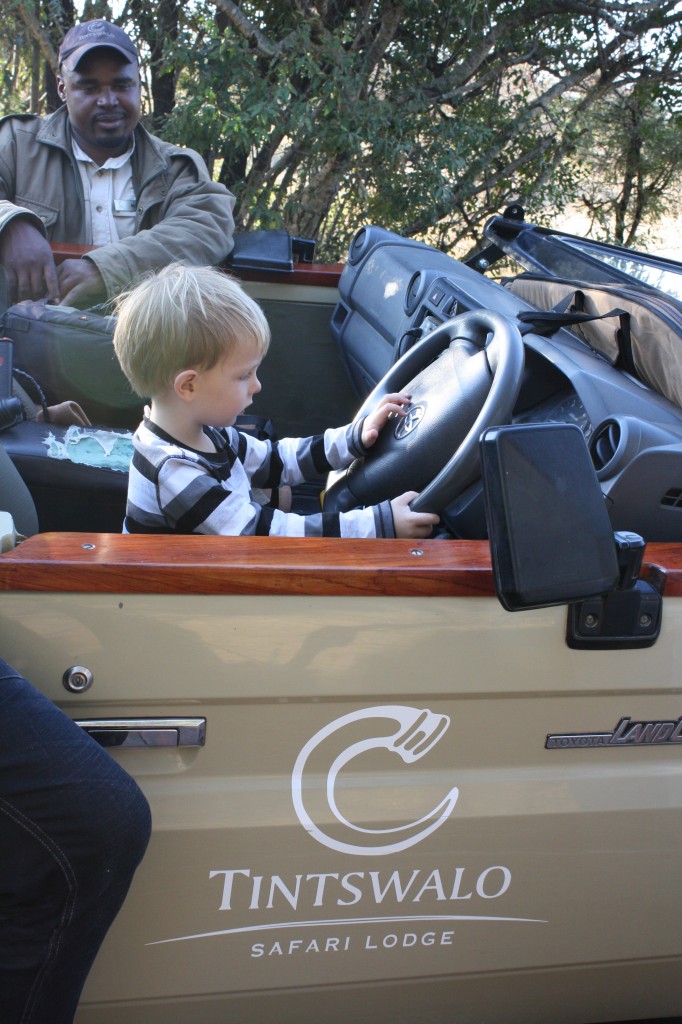
Solo (then aged 3) got to pretend to drive the Land Cruiser while on safari at Tintswalo, South Africa, which was definitely a highlight of the trip for him.

